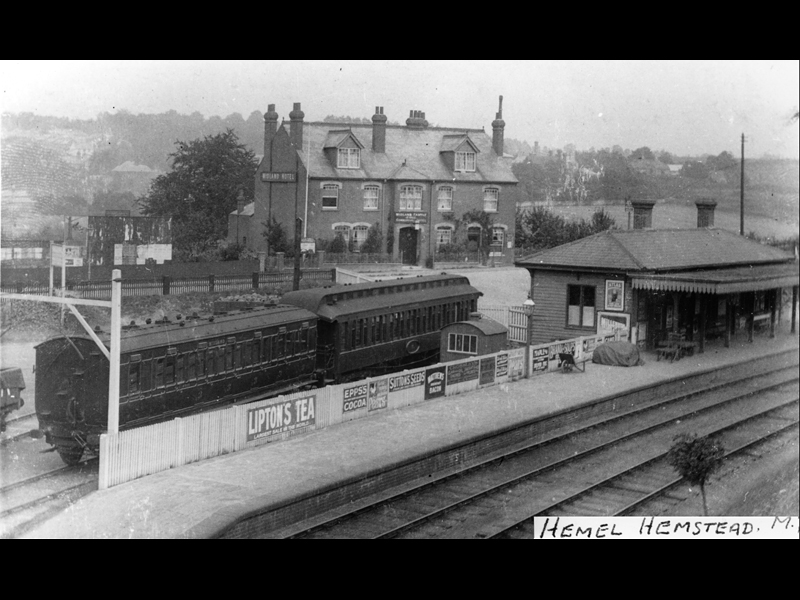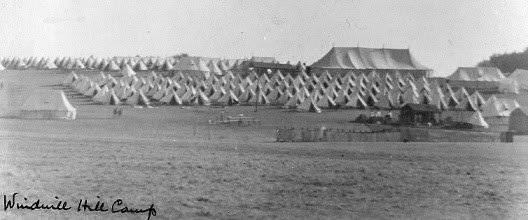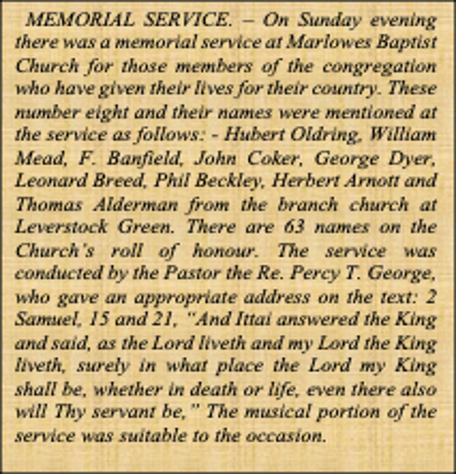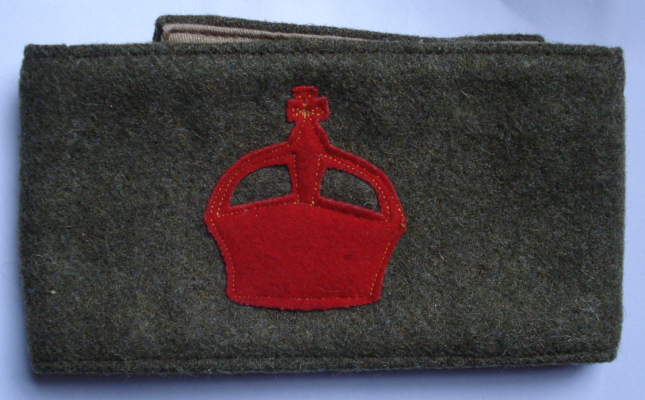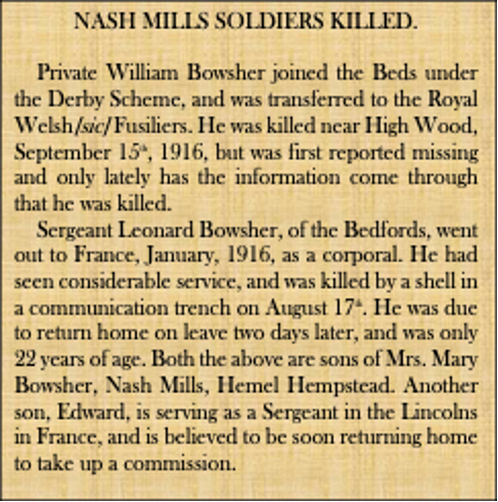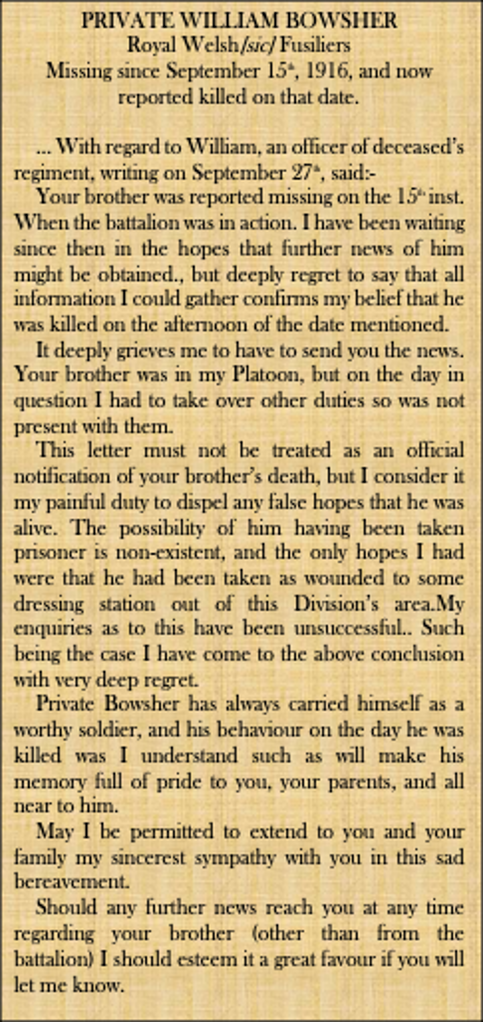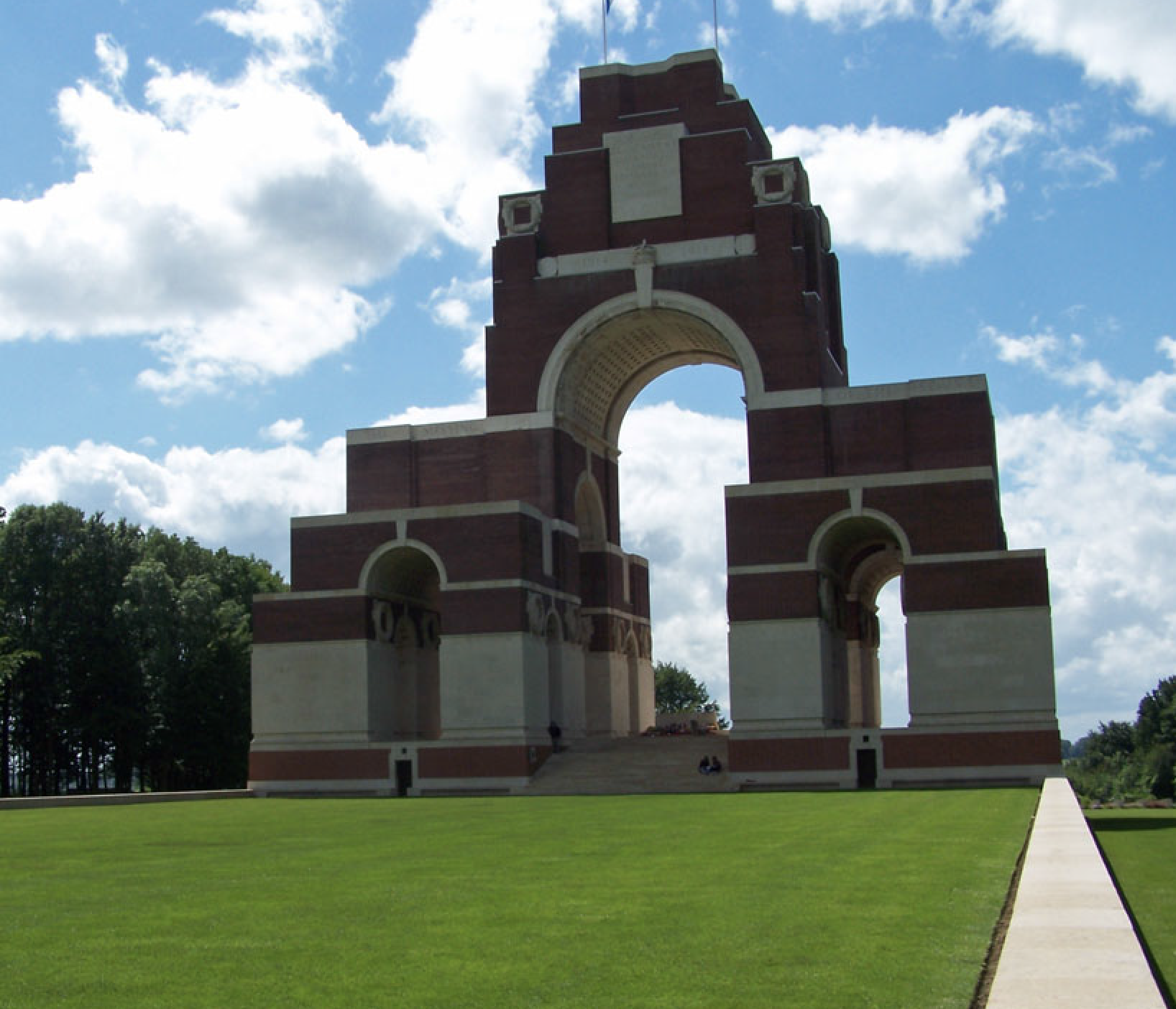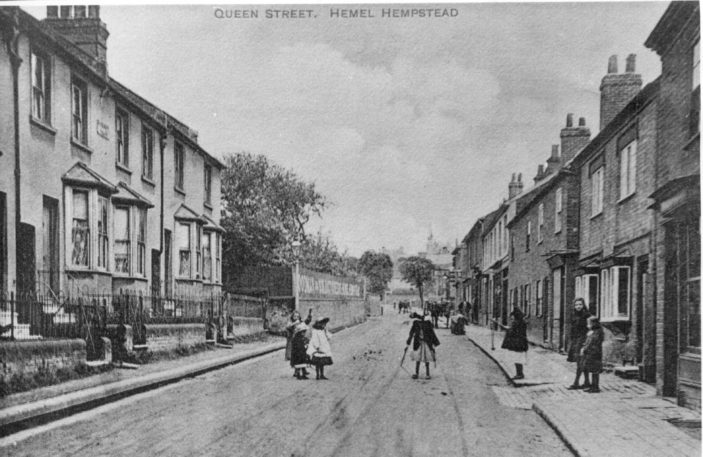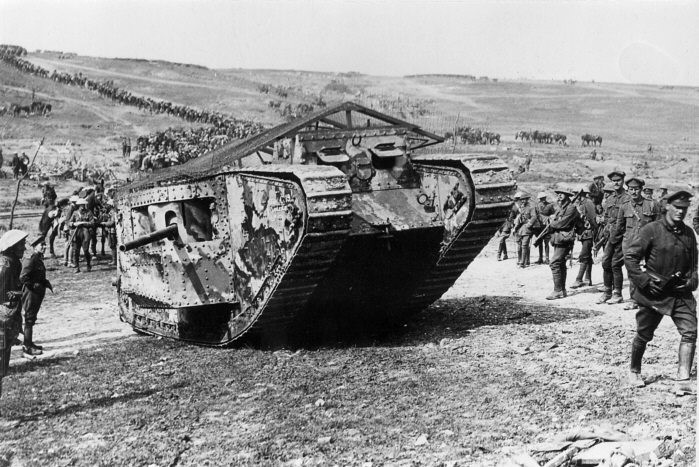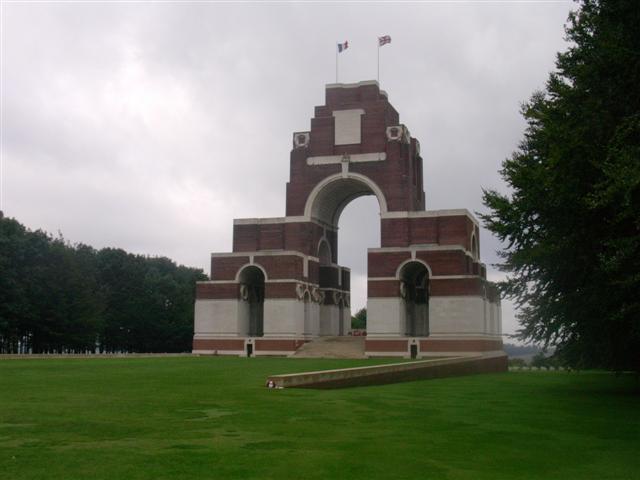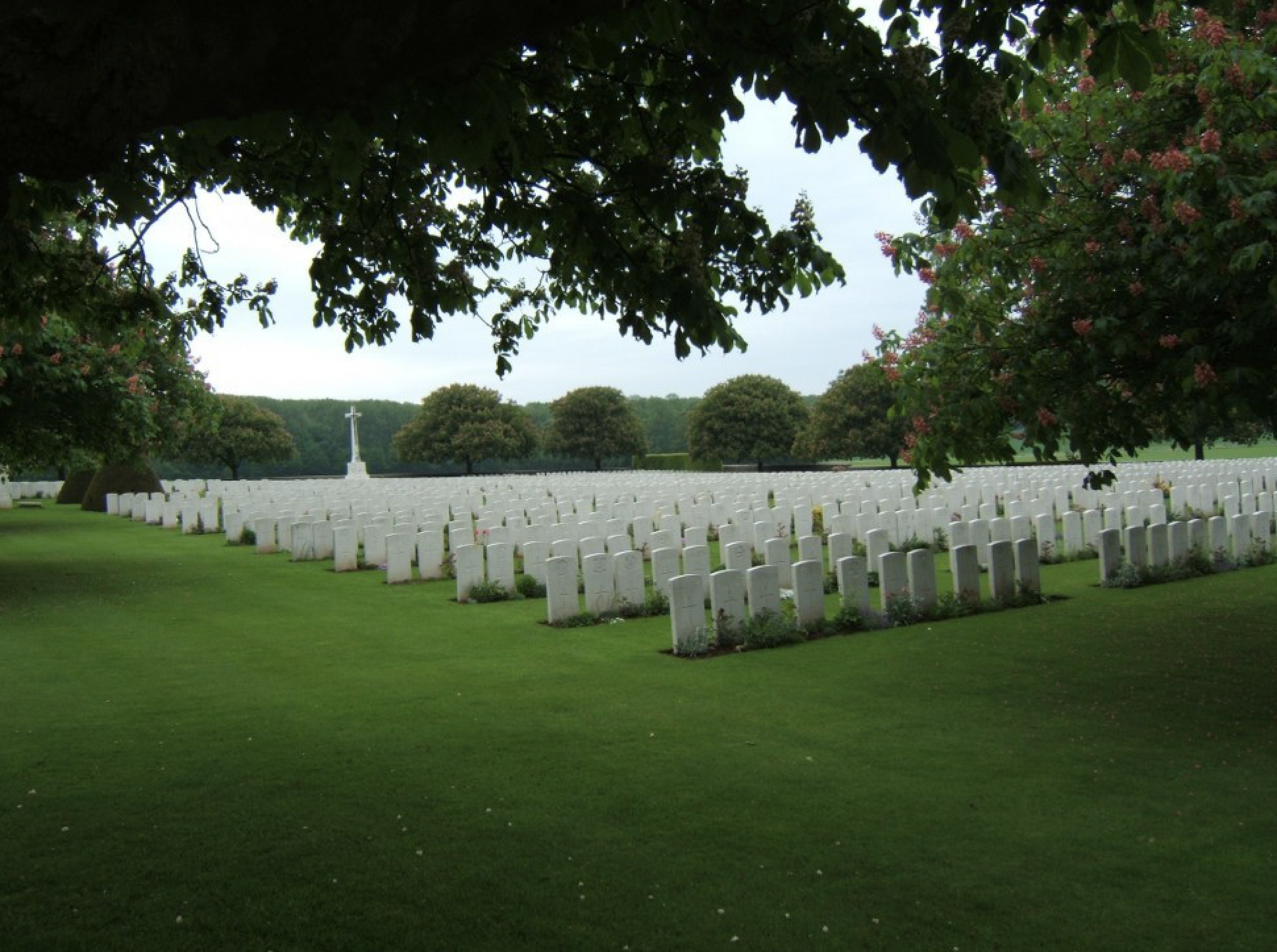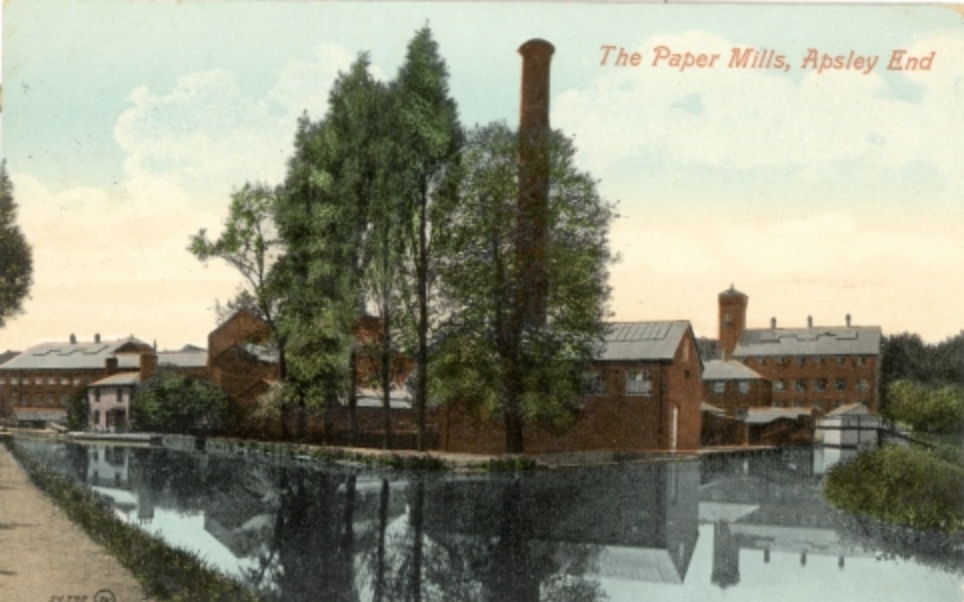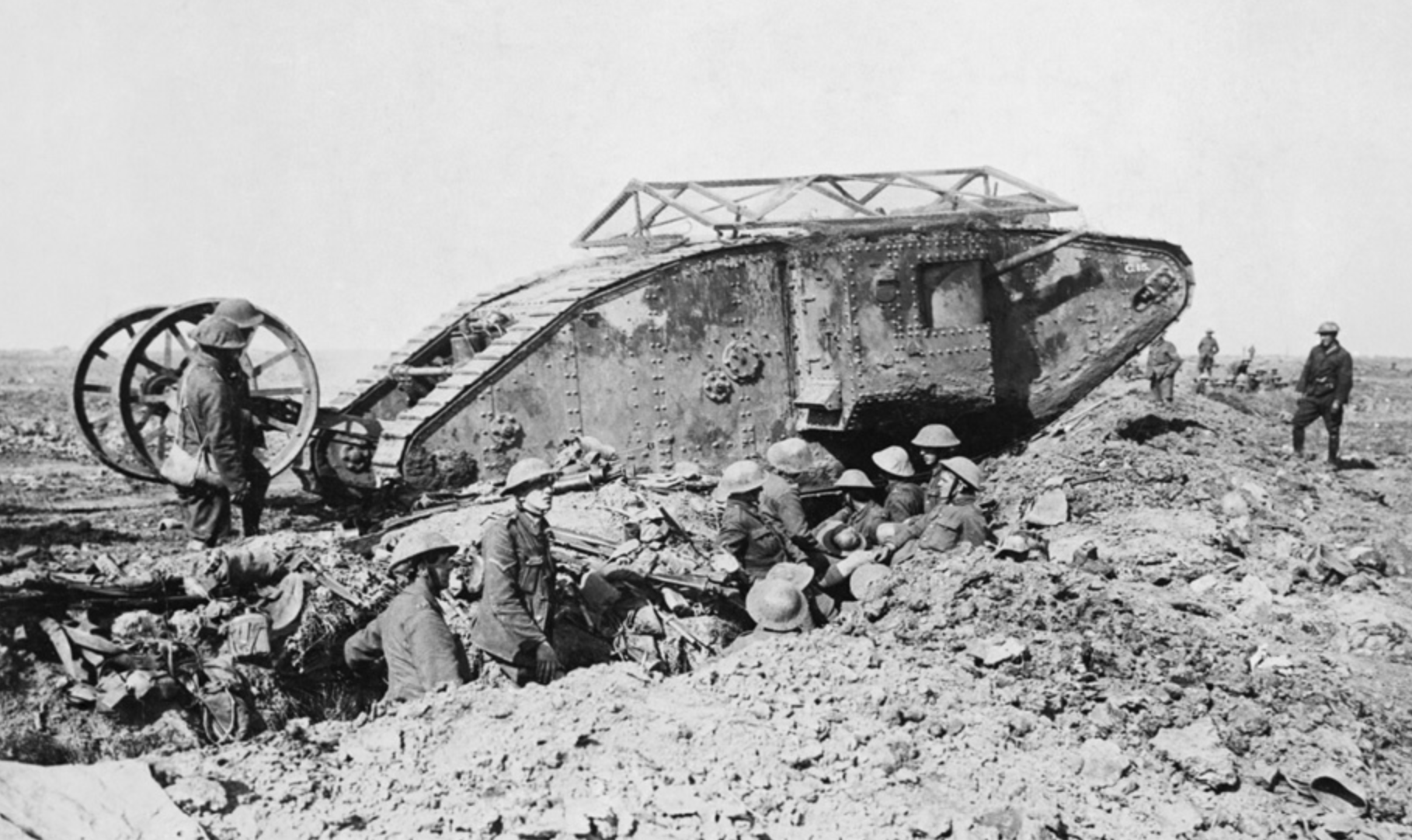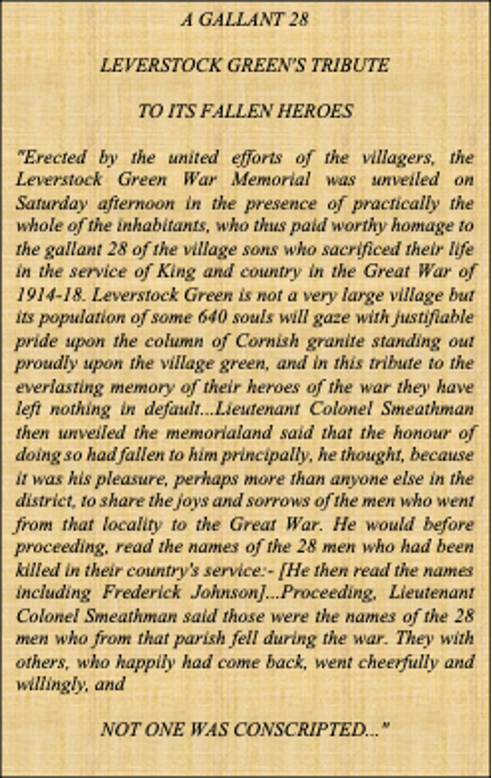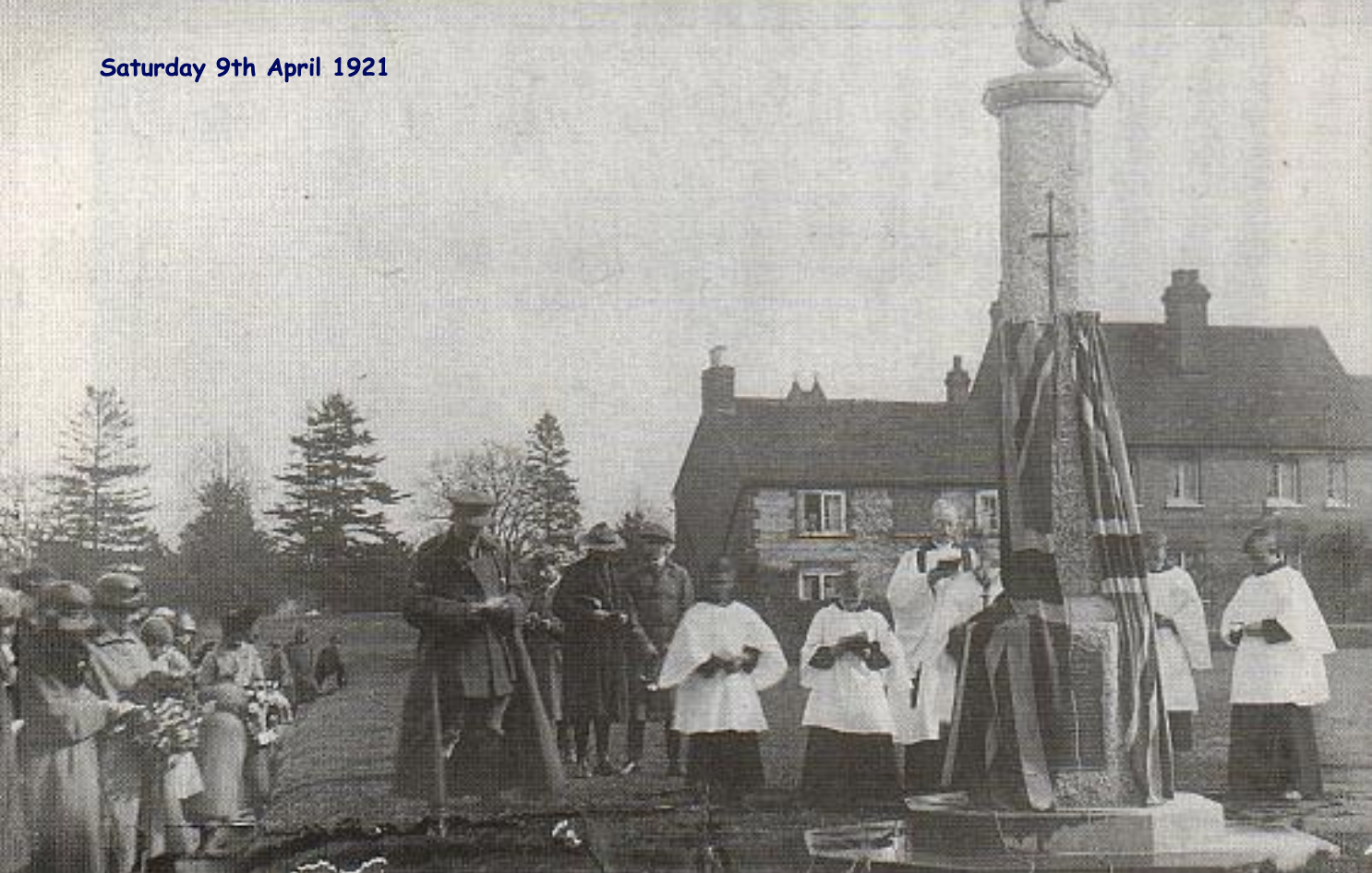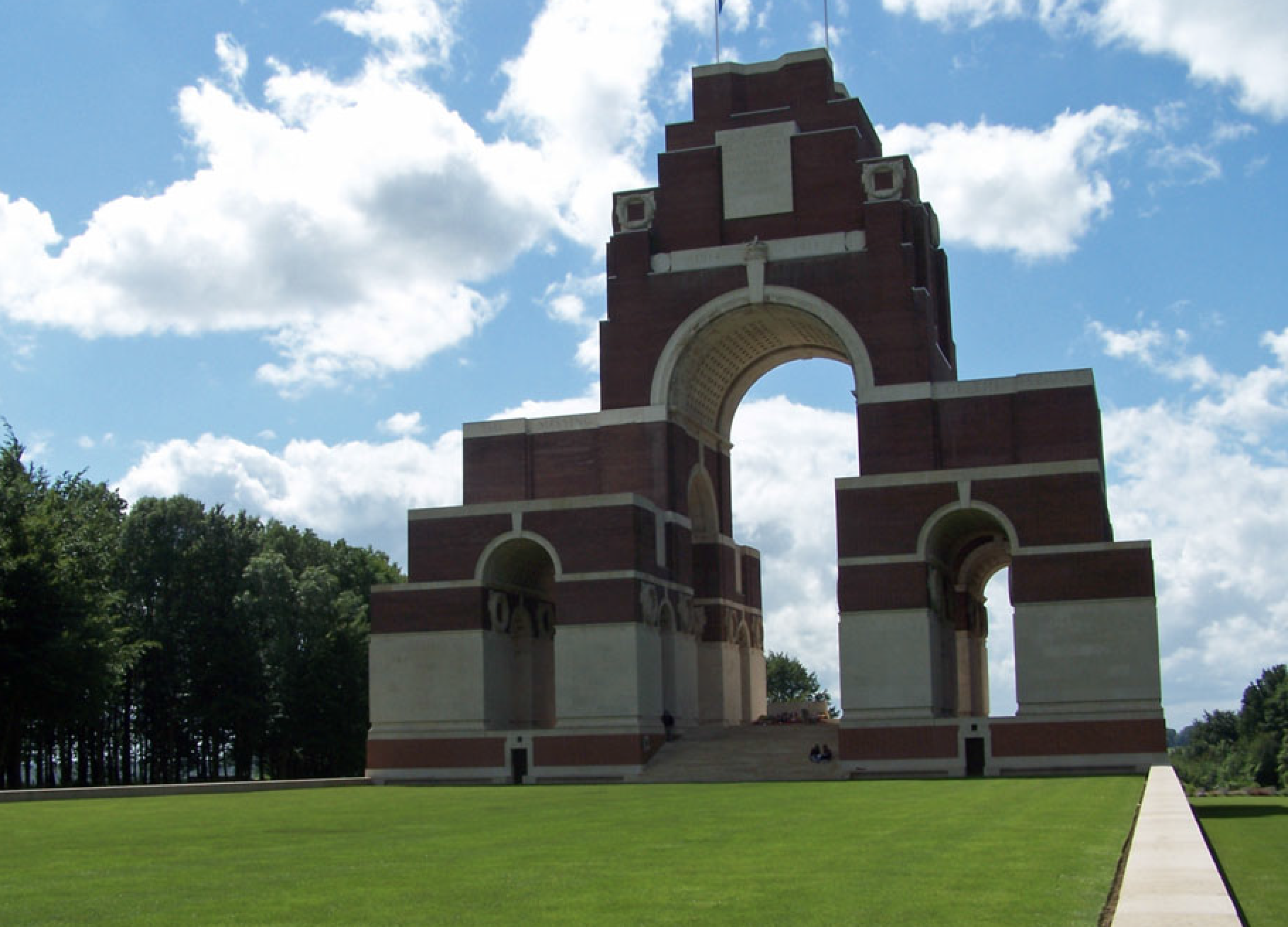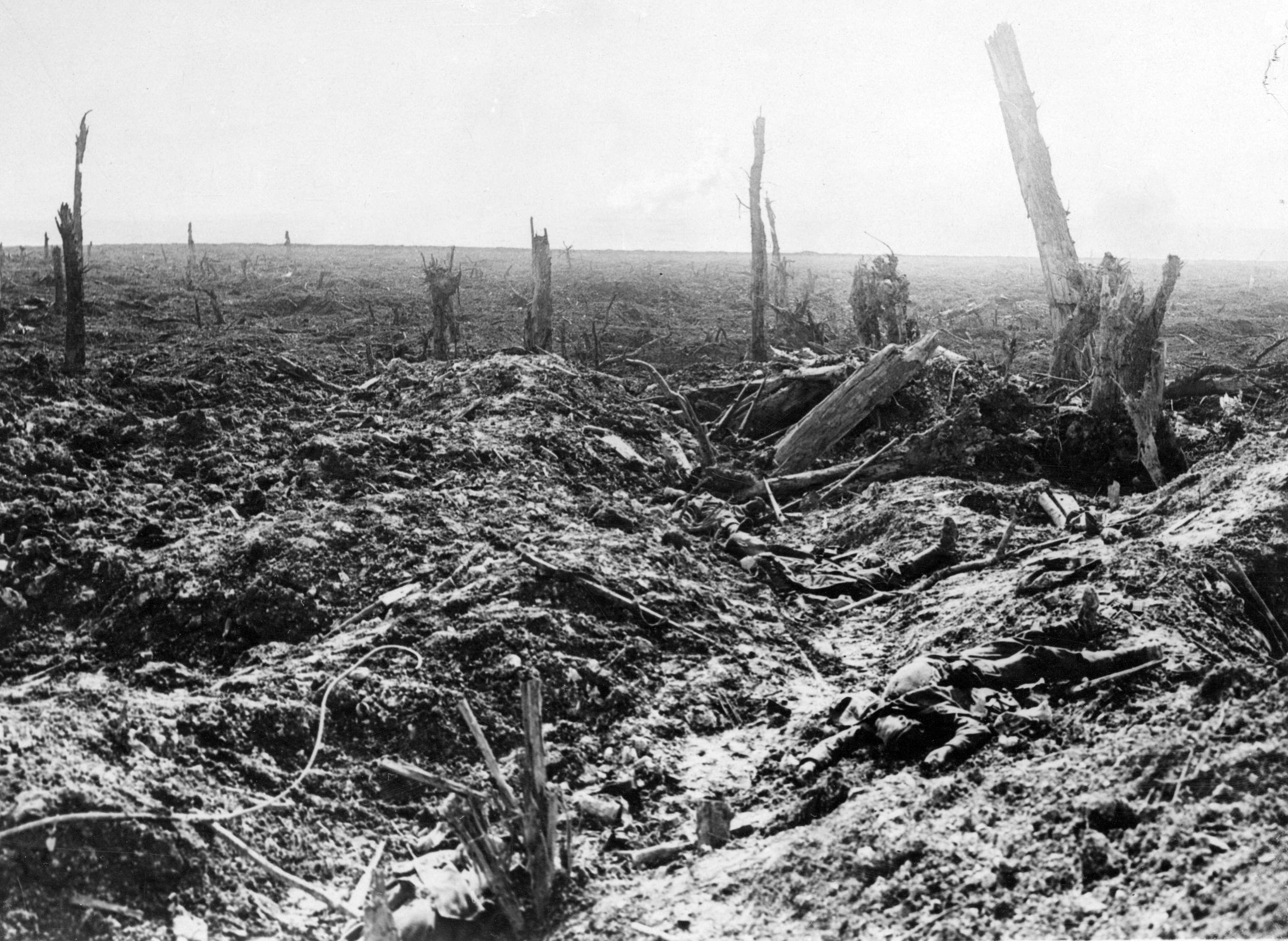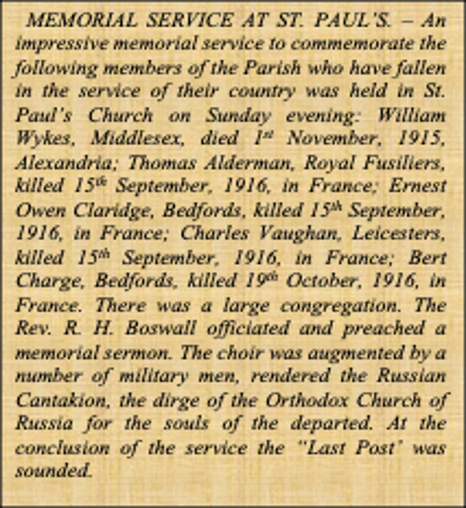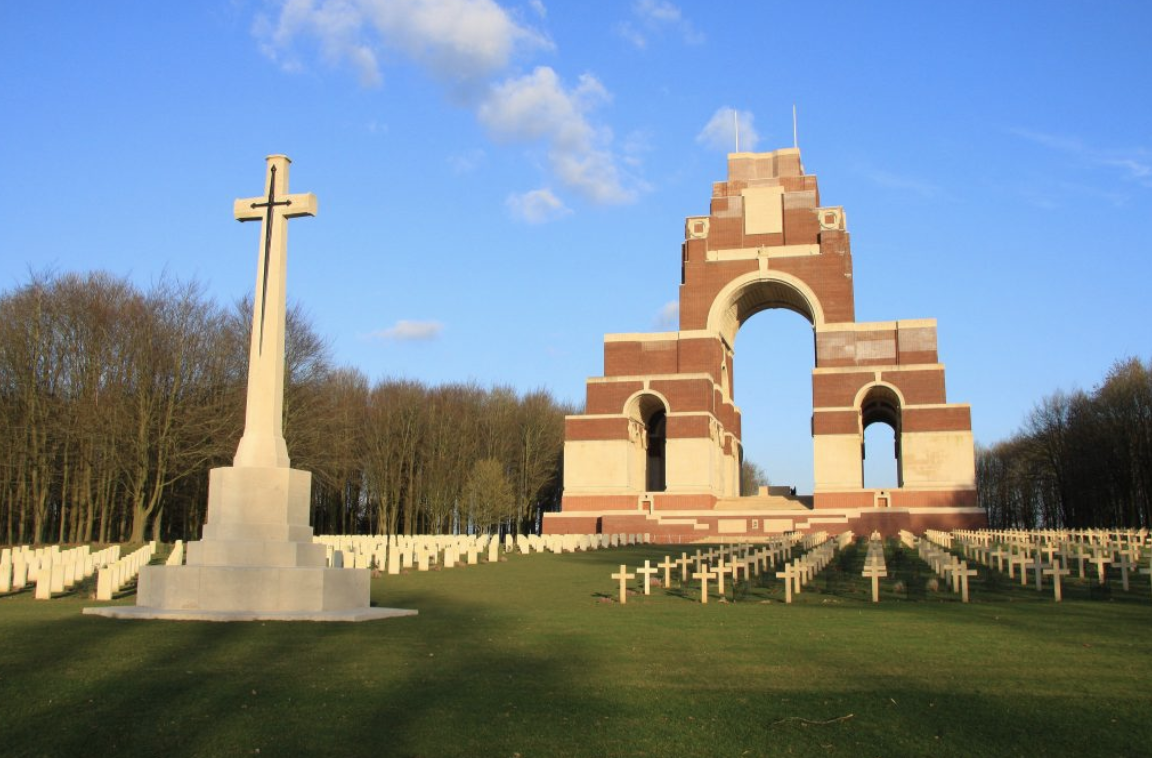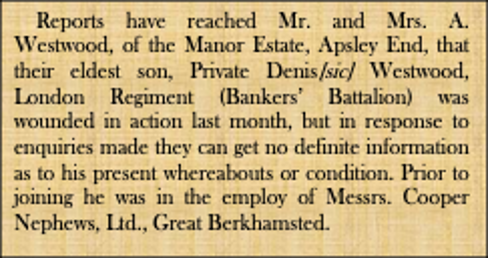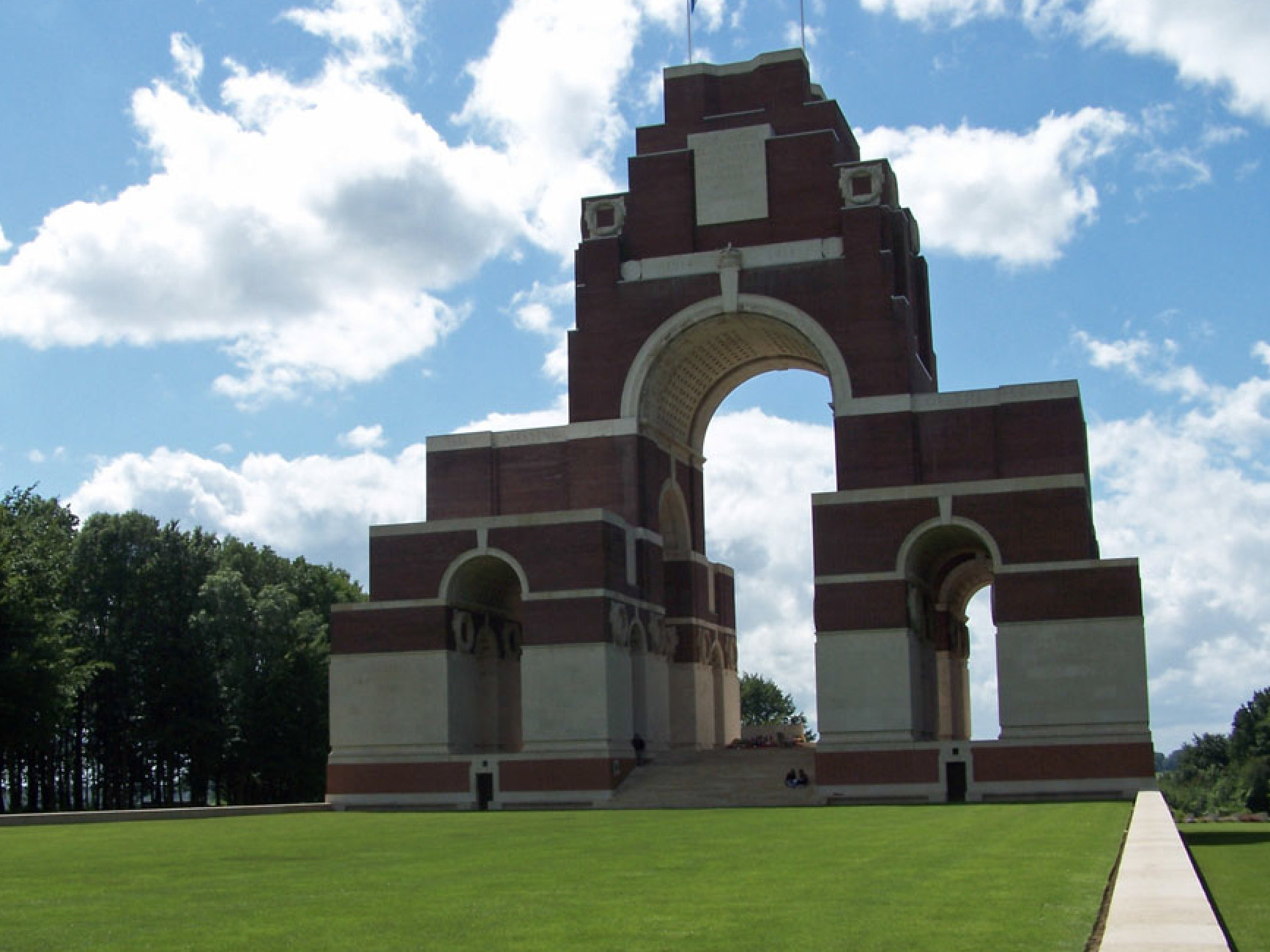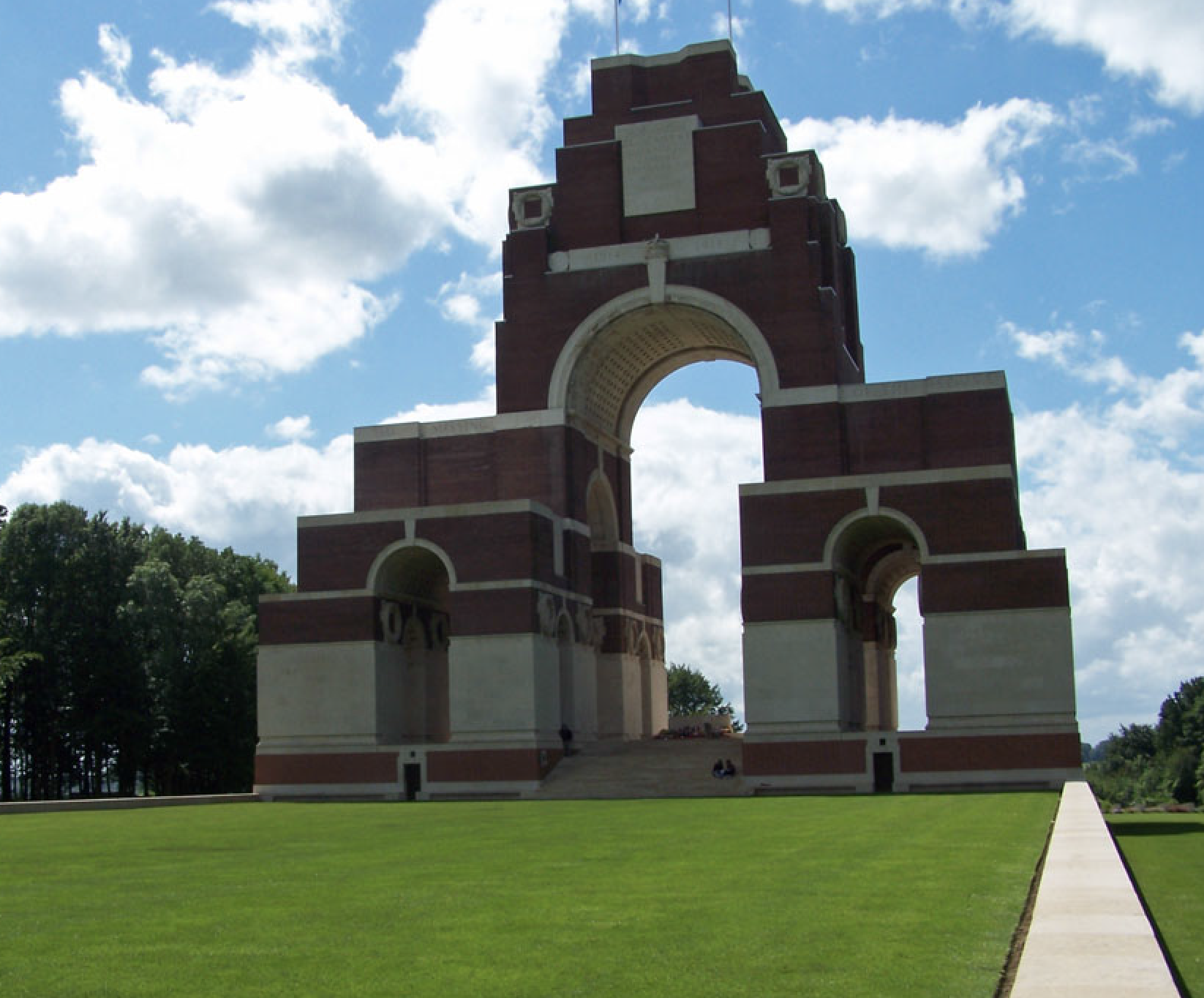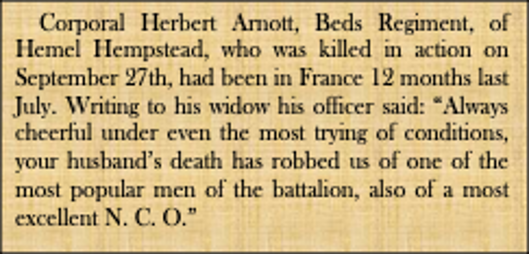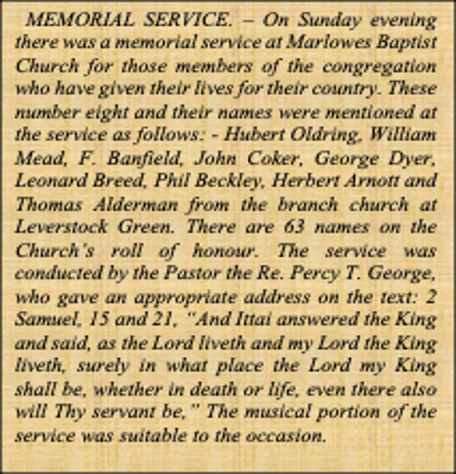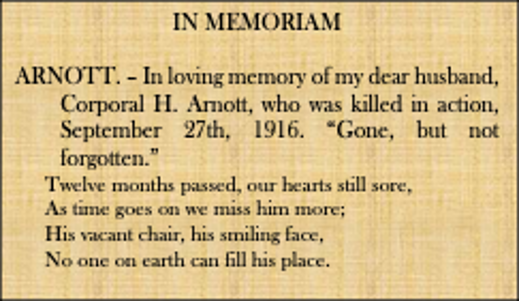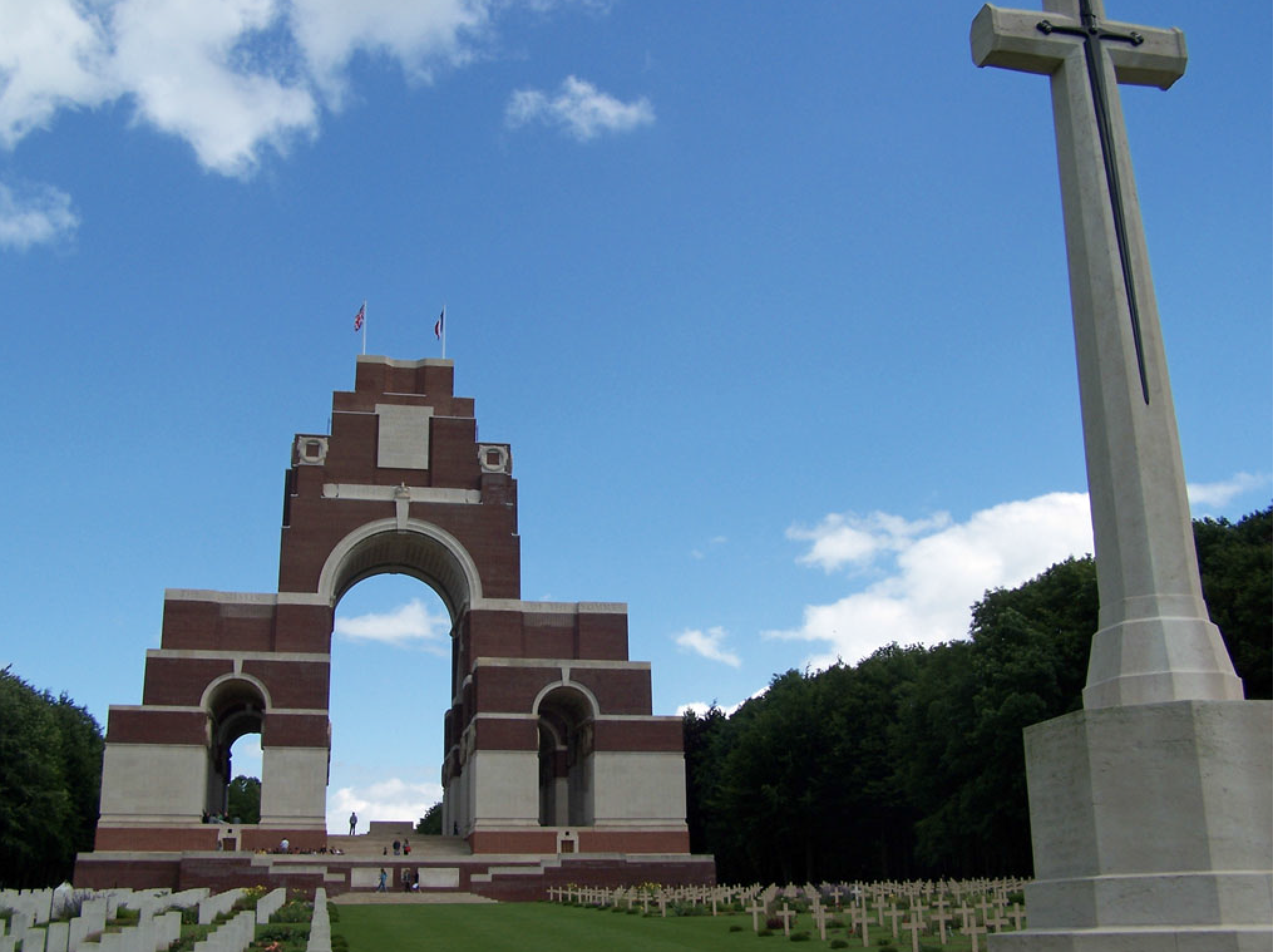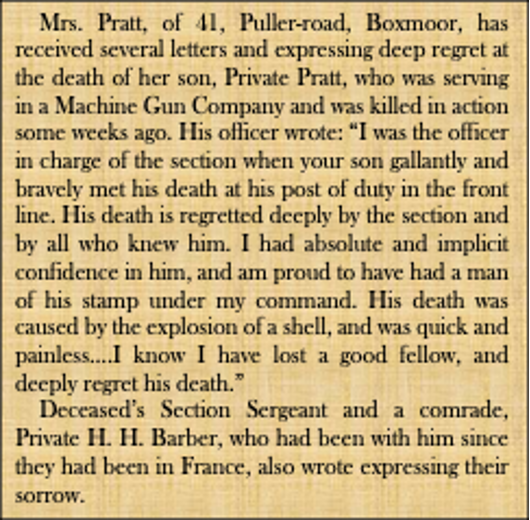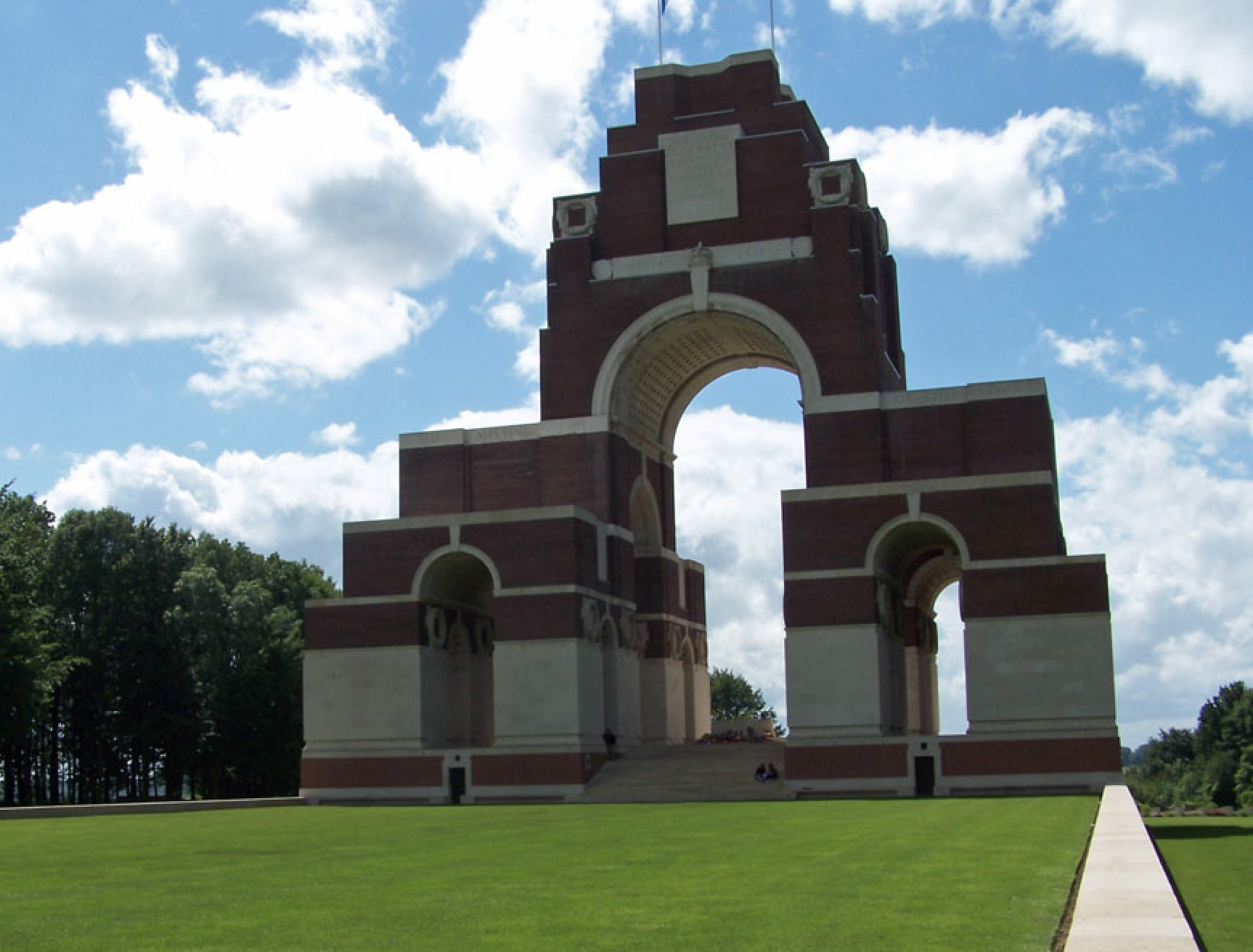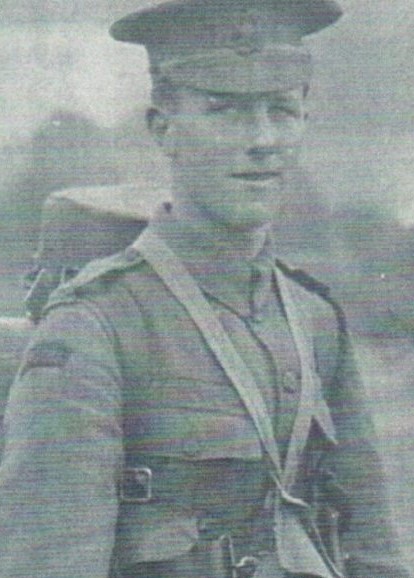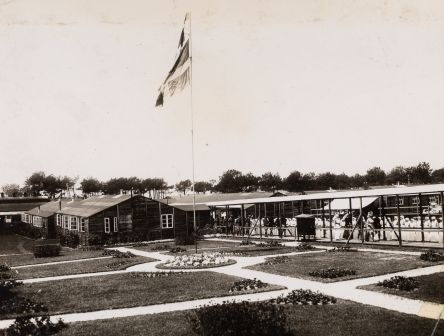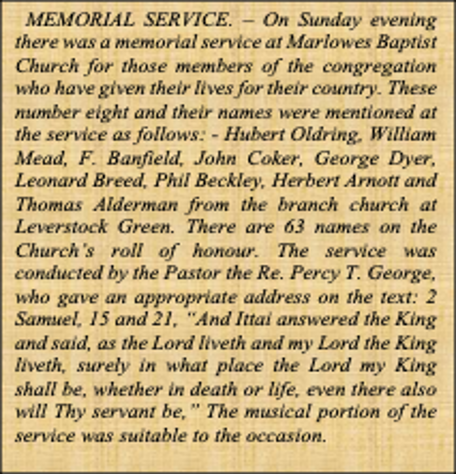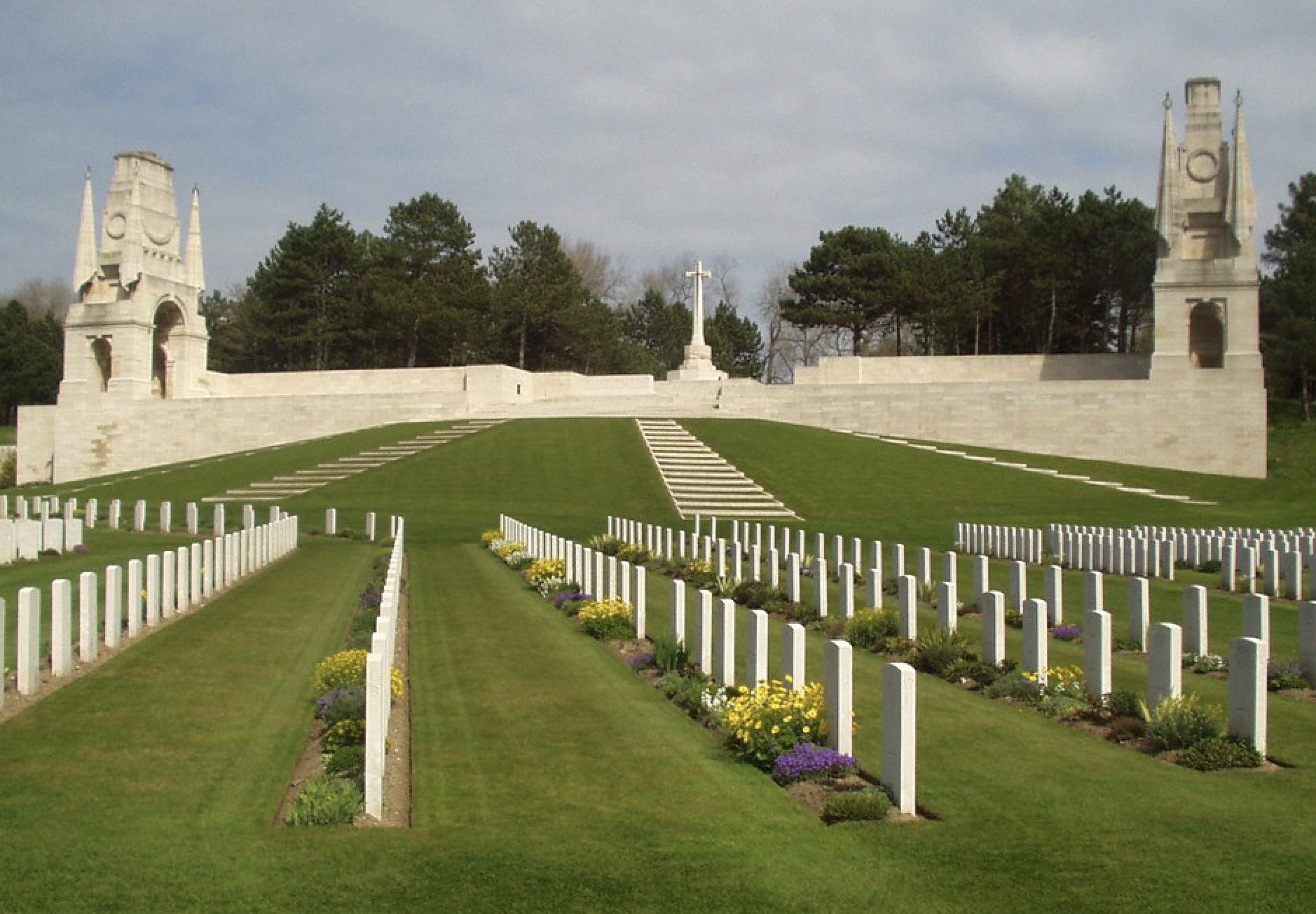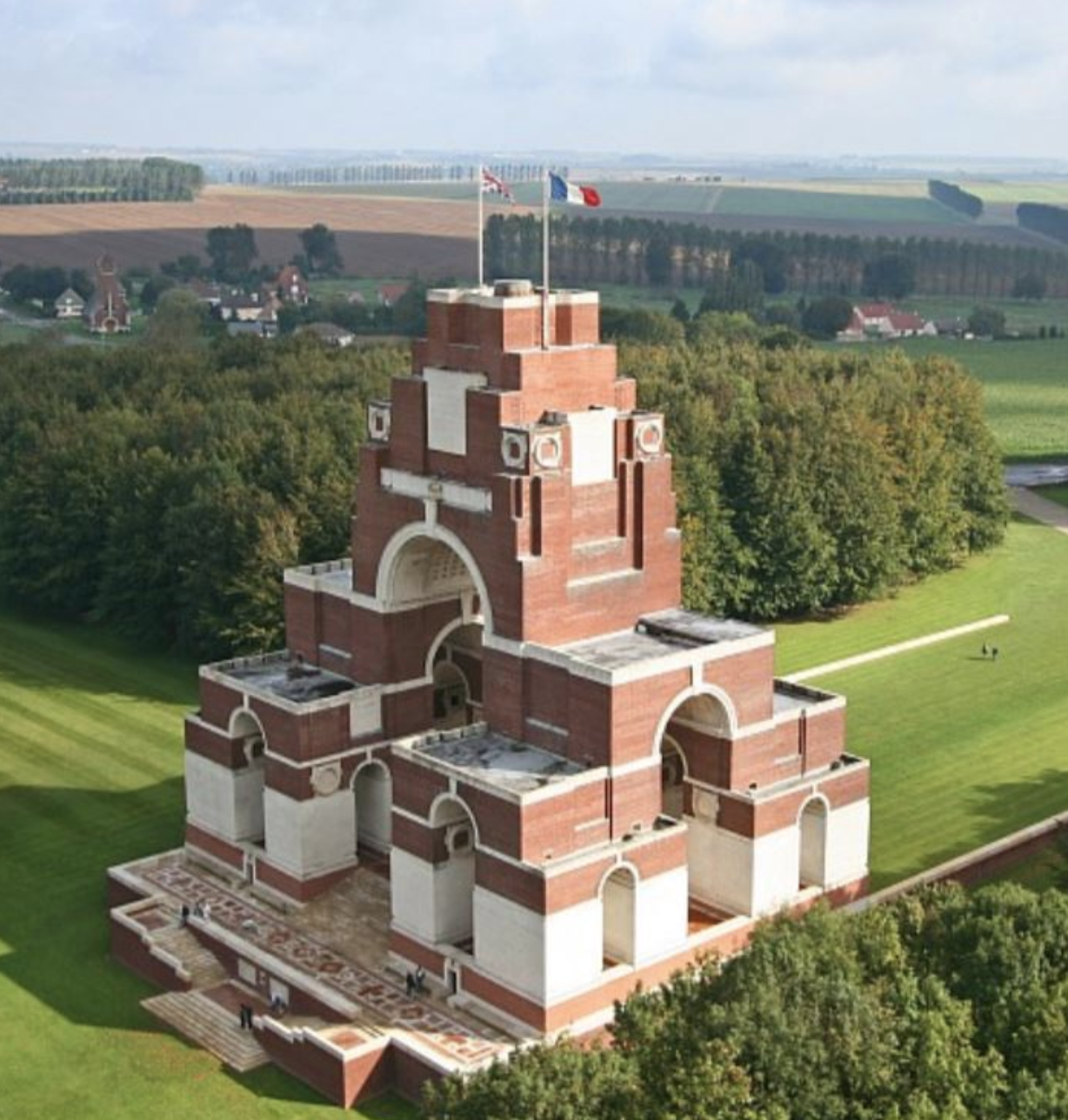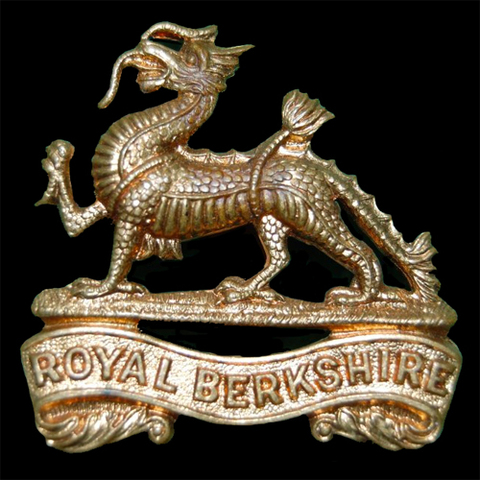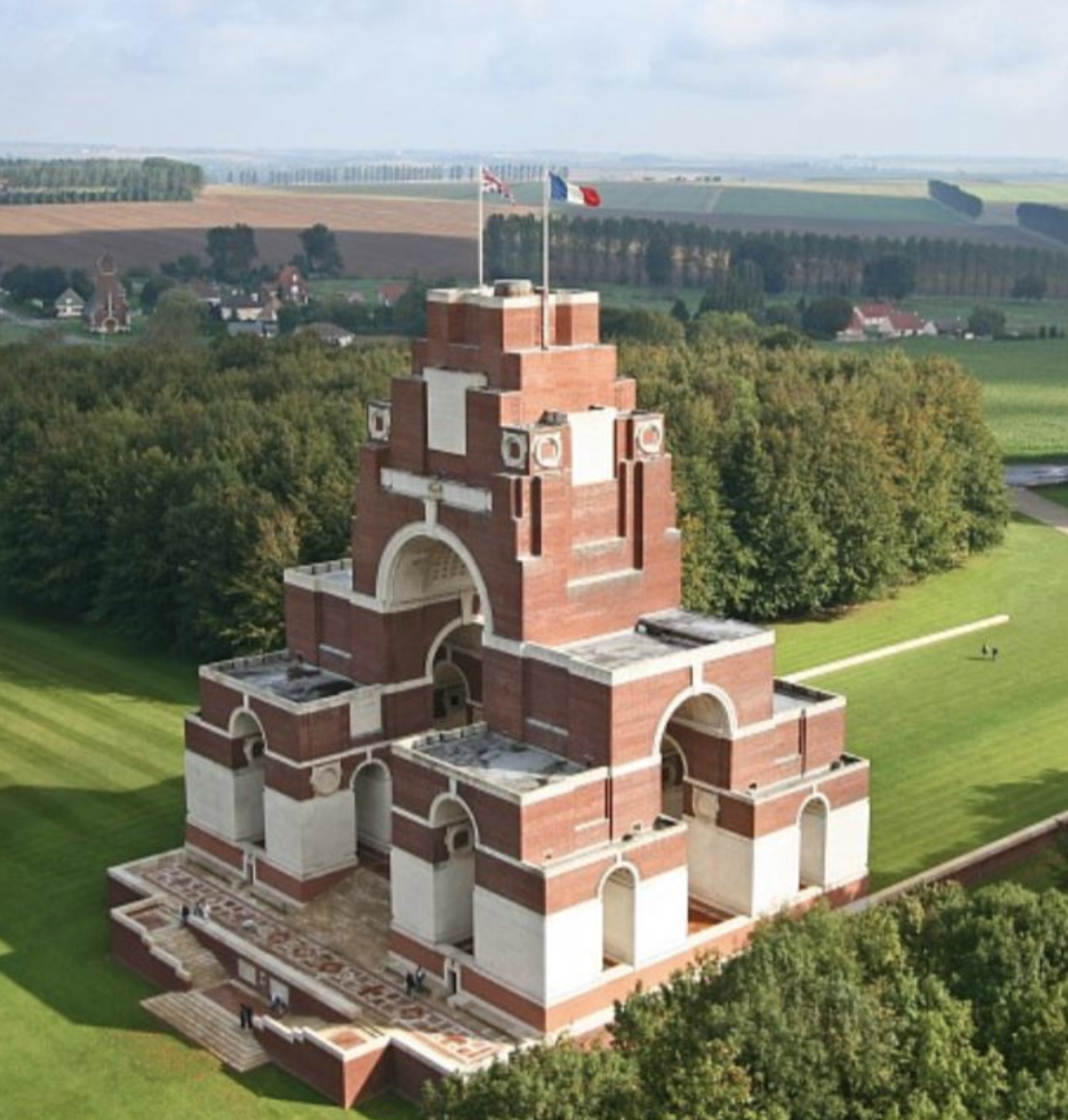Fallen in September 1916:
Thomas Alderman
William Harvard Bowsher
Ernest Owen Claridge
Henry Gamble
Arthur Janes
Frederick Taylor
Charles James Vaughan
Denis Augustus Westwood
John Henry Coker
Herbert F Arnott
Reginald Pratt
Philip Beckley
Robert Alfred Quatermass
Gordon Hemeley
THOMAS ALDERMAN
11098 Lance Corporal
32nd Bn. Royal Fusiliers
K.I.A. 15th September 1916
Interred Dartmoor Cemetery, Becordel-Becourt Plot: II A 12
Thomas Alderman was born in Harpenden on 10th July 1896, the fourth child of David and Lucy. His early life was spent in Harpenden, but the family moved a number of times as Thomas’ father David, a stockman, found jobs on different farms. His mother Lucy died early in 1906 leaving David alone to raise Thomas and his 4 siblings, Rosella, Cecil, Lilly and William.
By 1911 the family had settled at Woodlane End near Leverstock Green and Thomas, now 14 years old, was working as an errand boy at Dickinson’s Paper Mills.
Within two years, Thomas was employed by Midland Railways as a Porter and his trade union membership records his date of admission as 30th August 1913, in the month following his 17th birthday. The Midland Railway, Hemel Hempstead Branch or the ‘Nickey Line’ was one of two competing rail companies servicing Hemel Hempstead when Thomas joined.
From its early days serving the straw plait trade in Luton, the line was affectionately known locally as ‘Puffing Annie’. It was named for the engines which created much steam and smoke as they climbed the steep grade from the town centre up through Highfield. The main station was situated at the top of Midland Road opposite where the Midland Hotel stands today and about a mile from Thomas’ home in Woodlane End.
Thomas was amongst the early intake to the National Union of Railwaymen, which was newly formed on 29th March 1913, because of the consolidation of the Amalgamated Society of Railway Servants, the General Railway Workers' Union and the United Pointsmen's and Signalmen's Society. This amalgamation grew out of the 1911 national railway strike and by the end of 1913 it boasted a total of 267,611 members.
The Railways provided secure and relatively well-paid work at that time and Thomas would have earned an annual wage of approximately £57 for a six-day working week. ³ This equated to 22 shillings per week which was also the weekly food expenditure for a standard family in 1913.
No doubt he intended this job as a long-term position and despite the increasing speculation over possible hostilities, probably did not anticipate his time with the Midland Railways would end quite so soon.
Thomas’ war began when he enlisted for military service at Watford during January 1915, following which he was posted to the 13th Bn. Royal Fusiliers, 37th division assembling at Hounslow. Here he underwent basic military training before moving to Salisbury Plain during April 1915, where the next stage of training took place. He was stationed at Windmill Camp near Ludgershall and Battalion preparations culminated with an inspection of the troops by King George V on 25th June at nearby Sidbury Hill.
The departure to France started during the afternoon of 30th July 1915, and 13th Bn. needed two trains to transport it to Folkestone where the troops boarded the S.S. Golden Eagle. Escorted by two Royal Naval destroyers it sailed for Boulogne arriving later the same day.
Within two weeks the Battalion suffered its first death from shrapnel and a further 31 men were killed in the next ten months. Thomas saw action in the in the front line during this period, until January 1916 when he went down the line for several months. By the time of his return to the front line on 27th May 1916, he had been transferred to 32nd Bn., Royal Fusiliers, 41st division with the rank of Lance Corporal.
After nearly a year on active service Thomas received leave during June 1916 which was to be his last visit to his home before he died.
In early September 32nd battalion were in Fricourt Camp, three miles east of Albert in the Somme valley. On the 14th a move to the front line began in readiness for the assault on the German lines the next morning.
The Battle of Flers–Courcelette (15–22 September 1916) resulted in 29,376 British casualties with 41st Division suffering 3000. The 32nd Bn. casualties for the day were 293 of whom 87 were killed. This offensive was also notable for the first deployment of the newly invented ‘Tank’ in support of the infantry advances.
Midland Station, Hemel Hempstead, 1906 (Courtesy: http://www.disused-stations.org.uk)
Windmill Camp, Ludgershall (Courtesy:www.greatwarforum.org)
Extract fron The Hertfordshire, Hemel Hempstead Gazette and West Herts Advertiser, 4th November 1916
Dartmoor Cemetery, Becordel-Becourt, Somme, France (Courtesy: CWGC)
It was during the first day of this offensive that Thomas was seriously wounded and moved back 12km to XV corps main dressing station. He died of his wounds there on 15th September 1916.
As well as the Hemel Hempstead War Memorial, Thomas is commemorated on memorials at Leverstock Green, Carey Baptist church in the Marlowes and St Paul’s church, Hemel Hempstead. Articles in the Hemel Hempstead Gazette reported that he was remembered in memorial services at both Carey and St Paul’s in October and November 1916. (see extract)
He was eligible for the 1914-15 Star, the British War Medal and the Allied Victory Medal.
Thomas is buried in Dartmoor Cemetery, Becordel-Becourt, Plot II Row A grave 12.
He was only 20 years old when he fell.
He was entitled to the 1914-15 Star, the British War Medal and the Allied Victory Medal.
WILLIAM HARVARD BOWSHER
202268 Private
4th Bn., Royal Welsh Fusiliers
Killed in Action Friday, 15th September 1916
Remembered with Honour, Thiepval Memorial, Somme, France, Pier and Face 4 A
William Harvard Bowsher was born in Islington, Middlesex on Tuesday, 8th July 1890 and baptised the following month on Sunday, 3rd August at Holy Trinity church in Hoxton. He was the eldest of four sons born to William Thomas Bowsher and Mary Jane Culpitt and his three younger brothers were: George Edward, Leonard Henry and Frederick. William and Mary had a fifth child which died in infancy and which research has failed to identify. The three oldest boys fought in the Great War and Leonard was killed in August 1917, eleven months after William. Leonard’s biography also appears on this site.
When William was born his family lived at 30 Arlington Street, Islington and his father, William worked for a stationery company as a ‘Machine Ruler’. It was his father’s occupation which brought the Bowsher family to Nash Mills near Kings Langley, when he came to work for John Dickinson & Co. Limited in 1894.
In 1897 misfortune overtook the Bowsher family when William’s father William, died suddenly aged only thirty-nine. His death left his widow Mary Jane to raise the four young boys, so she found a job with Dickinsons as a ‘Hand Envelope Folder’. This was work that she was able to do from home, presumably due to some benevolence on the part of her employer, and this meant she could also look after the children. By 1901 her brother Harvard had also moved to Nash Mills to work for Dickinsons and was living with Mary and the boys and no doubt helping to raise his nephews.
By 1911, Mary aged forty-nine was a ‘Chapel Caretaker’ and by now all four of her sons and her brother were working with John Dickinson & Co. Limited at Apsley Mills. Twenty-year-old William was a ‘Light Porter’ in the factory.
William enlisted under the ‘Group Scheme’ popularly known as the ‘Derby Scheme’ after Edward Stanley the 17th Lord Derby who in October 1915 was appointed Director-General of Recruiting.
In early 1915 enlistments had averaged 100,000 men per month, but this was unsustainable and to try and keep the numbers up the upper age limit was raised from 38 to 40 in May 1915. It quickly became clear however, that voluntary recruitment was not going to provide the numbers of men required. The government therefore passed the ‘National Registration Act’ on the 15th July 1915 as a step towards stimulating recruitment and to discover how many men between the ages of 15 and 65 were engaged in each trade. All those in this age range who were not already in the military were obliged to register, giving details of their employment. The results of this census became available by mid-September 1915: it showed there were almost 5 million males of military age who were not in the forces, of which 1.6m were in the “starred” (protected, high or scarce skill) jobs.
Under the ‘Derby Scheme’ men aged 18 to 40 were informed that they could continue to enlist voluntarily or attest with an obligation to come if called up later on. However, all voluntary enlistment ceased on the 15th December 1915 and all new recruits were in effect conscripted from that point onwards.
Men who attested under the Derby Scheme, and who were accepted for service but chose to defer it, were categorised as “Class A”. Those who agreed to immediate service were “Class B”. Class ‘A’ men were paid a day’s army pay for the day they attested, given a grey armband with a red crown as a sign that they had volunteered and were officially transferred into Section B Army Reserve. They were sent back to their homes and jobs until they were called up. Each man was also classified as married or single status and into 23 groups according to their age. This determined when they would be called up and mobilised.
For William as a single man born in 1890 this, meant his call up was notified in January 1916 and he was mobilised a month later to begin training. He had enlisted with the Bedfordshire Regiment but on mobilisation was transferred to the 4th (Denbighshire) Battalion Royal Welsh Fusiliers and went to France in July 1916. The 4th Battalion was designated a ‘Pioneer’ unit and joined the 47th (London) Division near Albert on the 1st September 1916.
Fifteen days later William went into action for the first time in the Battle of Flers-Courcelette, historically significant for the use of the newly invented tank for the first time. On the 15th September he took part in the capture of High Wood but unfortunately did not survive the assault.
He was listed missing and it would be a year until he was officially declared killed in action on Friday, 15th September 1916.
A brief report of his death and that of his brother Leonard appeared in the Hemel Gazette in September 1917. (see extract)
Just a week later a letter from his C.O. 2nd Lieutenant D.J. Williams was published in the Gazette along with pictures of both William and his younger brother Leonard. (see extract)
He is commemorated on the John Dickinson & Co. Limited war memorial in Apsley.
William is Remembered with Honour on the Thiepval Memorial, Somme, France, Pier and Face 4 A.
He was 26 years old when he died
William was entitled to the British War Medal and the Allied Victory Medal.
Pte. William Bowsher c1916 (Courtesy: The Hertfordshire, Hemel Hempstead Gazette and West Herts Advertiser)
Group (Derby) Scheme Armlet 1915 (Public Domain)
Extract from The Hertfordshire, Hemel Hempstead Gazette and West Herts Advertiser 29th Sep. 1917
Extract from The Hertfordshire, Hemel Hempstead Gazette and West Herts Advertiser 6th Oct. 1917
John Dickinson & Co. Limited war memorial (Courtesy: Traquair Photography 30th Aug. 2016)
Thiepval Memorial, Somme, France (Courtesy: CWGC)
ERNEST CLARIDGE
20704 Private
8th Bn., Bedfordshire Regiment
Killed in Action Friday, 15th September 1916
Remembered with Honour, Thiepval Memorial, Somme, France, Pier and Face 2 C
Ernest Owen Claridge was born in Hemel Hempstead in late 1889 and baptised on Friday, 26th September 1890 at St Paul’s Church in the town. He was youngest child born to Charles Claridge and Elizabeth Markham who had ten children in all. Ernest’s older siblings were: William, Alfred, Mary Anne, Millicent, Emma, Annie, Horace, Nellie and Ellen.
When Ernest was born his family were living at 50 Queen Street in Hemel Hempstead and his father Charles worked as a ‘Carpenter’. By 1901 the family had moved a short distance to 72 Queen Street and Ernest’s sister Emma had married and her husband Arthur Gurney and their daughter Lily lived with the family.
A year later in 1902, Ernest’s father Charles died aged sixty-two and by 1911 only Ernest and his older brother Horace were living with their mother Elizabeth, now at 63 Queen Street. Ernest aged twenty-one was working as a ‘Packer’ at Apsley Mills with John Dickinson & Co. Limited. By this time the Claridge family had lived on Queen Street since Charles and Elizabeth married in 1875 and Elizabeth would remain on Queen Street until her death in 1929, a total of fifty-four years.
Ernest was called up for service under The Military Service Act of the 27th January 1916 which brought conscription into play for the first time in the war. Along with the Defence of the Realm Act, it was possibly the most important piece of legislation in placing Britain onto a “total war” footing. The procedure for calling up the classes of men defined in the Act was laid down in Army Council Instruction 336 of 1916. The procedure was generally the same as that used to call up men from the Groups of the Derby Scheme.
Ernest would have been immediately categorised as ‘Class A’ (over 18 and with no exemptions) and further classified in ‘Group 8’ based on the year of his birth. As a result, he enlisted with the 8th Battalion Bedfordshire Regiment in June 1916 and after his basic training was sent to France three months later in September.
His time at the Front was brief and within two weeks of arriving he fought in the Battle of Flers-Courcelette where tanks were used for the first time in a war. An account of the first day of the battle was recorded in the Battalion War Diary: "15 Sep 1916 Battalion ordered to take QUADRILATERAL assisted by the Heavy Section of the M.G. Corps with "TANKS" advance about 500 yds NE and dig in. Battn was in a position for attack about 4.30 a.m. ZERO hour 6.20 a.m. Three waves were supplied by D, D [sic] and A Coys under Capt Hatch , 2/Lt Hodges and Lt Draisey respectively to attack the QUADRILATERAL, which was on our left flank, whilst B Coy co-operated by bombing down trench leading to it. At 6.0 a.m. heavy artillery opened slow barrage on Line MORVAL - LES BOEUFS. At ZERO hour (6.20 a.m.) intense artillery barrage opened and unluckily was cut short where our 3 companies were drawn up for the attack in shell holes. This mistake caused many casualties. Our attacking companies pushed forward and though supported by 1/The Buffs and later re-enforced by the 2/York & Lancaster Regt failed to take the position. "TANKS" did not arrive to assist and the position was not heavily shelled previous to the attack. Brigade ordered original trenches to be held and await orders. As battalion had suffered very severely in casualties, 6 Officers killed and 7 wounded we were relieved by 2/Y & L at 6.0.p.m. and put in brigade reserve in trenches S.E. of GUILLEMONT." Despite the use of tanks, the attack failed, and the casualties incurred by the 8th Battalion were high.
Ernest died during the assault, killed in action on Friday, 15th September 1916.
His death was commemorated in a memorial service held at St Paul’s Church on Sunday, 5th November 1916 brief details of which were published in the following week’s edition of the Hemel Gazette. (see extract)
He was also commemorated on the John Dickinson & Co. Limited war memorial in Apsley.
Ernest is Remembered with Honour on the Thiepval Memorial, Somme, France, Pier and Face 2 C.
He was 26 years old when he died
Ernest was entitled to the British War Medal and the Allied Victory Medal.
Queen Street, Hemel Hempstead where Ernest grew up (Courtesy:https://www.ourdacorum.org.uk)
The first "Tanks" at the Battle of Fler-Courcellette (Courtesy: https://www.thehistorypress.co.uk)
Extract from The Hertfordshire, Hemel Hempstead Gazette and West Herts Advertiser 11th Nov. 1916
John Dickinson & Co. Limited War Memorial (Courtesy: Traquair Photography 30th Aug. 2016)
Thiepval Memorial, Somme, France (Courtesy: CWGC)
HARRY GAMBLE
16361 Private
8th Bn., Bedfordshire Regiment
Killed in Action Friday, 15th September 1916
Remembered with Honour, Guillemont Road Cemetery, Guillemont, Somme, France, Grave VII.E.2.
Henry Gamble, known as Harry, was born in Boxmoor, Hertfordshire on Thursday, 29th March 1894 the third and youngest son born to Frederick Gamble and Emma Collier. Harry had four siblings who were: Robert William (known as William), Frederick, Annie and Hilda. His sister Annie died in 1892 aged one and his brother William also fought in the Great War. William was killed six months before Harry in March 1916 and his biography also appears in this book.
The Gamble family lived at 57 Horsecroft Road in Boxmoor when Harry was born, and his father Frederick was a labourer on the railways. Frederick was from Welham in Leicestershire and had come south to Boxmoor with his job in about 1886. He subsequently met a local girl, Emma Collier, and they were married in 1889 in Boxmoor.
Harry started his education at Boxmoor JMI school on the 20th February 1901 and completed Standards I and II before he left in March 1907 to start work as a ‘Caddy’ on a golf course. He worked at Boxmoor Golf Links in Box Lane which had been founded in 1890 on common land leased from the Boxmoor Trust.
The family was still living at 57 Horsecroft Road in 1911 and Harry, aged seventeen, had moved jobs to work as a ‘Wood Sawyer’s Assistant’ at G.B. Kent & Sons, the brush makers in Apsley. Shortly before the outbreak of war, Harry moved to a new job with John Dickinson & Co Limited at Apsley Mills and it was from here that he left to enlist.
Harry attested at Watford in September 1914 joining the 8th (Service) Battalion Bedfordshire Regiment and initially went to the Regimental HQ at Bedford to be mobilised. Other than a brief spell in Brighton, most of his training was undertaken in Surrey, with almost seven months being spent in the sprawling New Army training area around Woking.
Whilst Harry was training at Woking, his mother Emma died aged 48. She was buried at Heath Lane Cemetery in Hemel Hempstead on the 11th May 1915.
Finally, the increasingly restless men of the 'Hungry 8th', as the Battalion was nicknamed, received orders to mobilise and prepared to ship out. At 11pm on the 28th August 1915, the Battalion boarded the troop trains at Chobham Station and left for Dover. After transferring straight onto troop ships, it arrived at Boulogne early on the 30th August 1915.
In 1915 Harry fought in and survived the Battle of Loos and he was in the trenches at Wieltje near Ypres, on 19th December when the Germans first used phosphene gas against the British. They released 88 tons of the gas from cylinders causing 1069 casualties and 69 deaths. Harry also survived this action.
The 8th Bedfordshires were in Belgium for most of 1916 until moving to France to take part in the Battle of the Somme in early September. On the 15th of the month, Harry took part in the Battle of Flers-Courcelette on a day which proved costly for the Battalion.
Players and Caddies in the early days of Boxmoor Golf Links (Courtesy: Roger and Joan Hands,https://www.ourdacorum.org.uk)
John Dickinson & Co. Limited war memorial (Courtesy: Traquair Photography 30th Aug.2016)
Guillemont Road Cemetery, Guillemont, Somme, France (Courtesy: CWGC)
The casualties incurred where high during the battle and Harry was one of the men listed as missing following the first day of action. He was subsequently presumed dead and officially recorded as killed in action on Friday, 15th September 1916.
He is commemorated on the John Dickinson & Co. Limited war memorial in Apsley.
Harry is Remembered with Honour in Guillemont Road Cemetery, Guillemont, Somme, France where he is interred in Grave VII.E.2.
He was 22 years old when he died
Harry was entitled to the 1914-15 Star, the British War Medal and the Allied Victory Medal.
ARTHUR JANES
20744 Private
8th Bn., Bedfordshire Regiment
Killed in Action Friday, 15th September 1916
Remembered with Honour, Thiepval Memorial, Somme, France, Pier and Face 2 C
Arthur Janes was born in Edlesborough near Leighton Buzzard in Buckinghamshire in the Spring of 1897. He was born to George Janes and Lucy Emmerton He was raised by relations; initially he lived with his Uncle and Aunt, Edward Fountain and Sarah Emmerton; then he lived with his cousin Philip Fountain and his wife and Charlotte Osborne.
In 1901 four-year-old Arthur lived in Eaton Bray, Buckinghamshire and his family worked on the land as ‘Agricultural Labourers. However, when his cousin Philip married Charlotte Osborne in 1903, the six year old Arthur moved to live with them at No.2 Doolittle in Apsley End. Philip worked for John Dickinson & Co. Limited in Apsley Mills, as did Arthur when he turned thirteen. He and Philip worked in the Bookbinding department, Arthur as a ‘Leather Cutter’ and Philip as a ‘Book Fordwarder’[sic], which may have been the packing and despatching of the finished products.
On the outbreak of war Arthur was too young to enlist aged seventeen, but he joined the Colours immediately after his eighteenth birthday in June 1915. He attested at Bedford and joined the 8th (Service) battalion Bedfordshire Regiment. The 8th Battalion was attached to the veteran 6th Division and came under the orders of the 16th Brigade which comprised of; 8th Battalion, the Bedfordshire Regiment, 1st Battalion, the Buffs, 1st Battalion, the Kings Shropshire Light Infantry and 2nd Battalion the York and Lancaster Regiment.
Arthur was sent to the vast ‘New Army’ training area in Woking where the 8th Bedfords had been preparing since December 1915. His comrades were mobilised and went to France at the end of August 1915 and moved to the trenches around Ypres on the Yser Canal. Arthur completed his training and followed them in 1916.
The records available do not state exactly when he went to France, but it may have been as late as May 1916. The war diary recorded: ‘13 May 1916 Camp E, Wood A30. - Drill and training by Coys. - Reinforcements 1 off and 122 O.R. joined today.’
He saw action in the trenches around Ypres until moving to Thiepval near Béthune on the Somme in August. By mid-September he was near Longueval as the 8th Battalion prepared for an assault on High Wood where the Germans were heavily entrenched. This was the Battle of Flers-Courcelette where a new British invention was deployed on a battlefield for the first time in history – the Tank.
On the 15th September, the attack began and following fierce fighting throughout the day the assault had failed and the Battalion was relieved. However, the casualties incurred were significant due to the heavy machine gun enfilade from the enemy positions. Arthur was listed missing ‘presumed killed’ at the end of this action.
Arthur’s death was subsequently confirmed as killed in action on Friday, 15th September 1916.
He was commemorated on the John Dickinson & Co. Limited war Memorial in Apsley and in St Mary’s church in the village.
Apsley Mills where Arthur worked (Courtesy:http://www.hertfordshire-genealogy.co.uk)
Mark 1 Tank first deployed at the Battle of Flers-Courcelette (Courtesy: IWM Q 2486)
John Dickinson &Co Limited War Memorial Apsley End (Courtesy: Traquair Photography 30th Aug. 2016)
Thiepval Memorial, Somme, France (Courtesy: CWGC)
Arthur is Remembered with Honour on Thiepval Memorial, Somme, France, Pier and Face 2 C.
He was only 19 years old when he died.
Arthur was entitled to the British War Medal and the Allied Victory Medal.
FREDERICK TAYLOR
22080 Private
8th Bn., Bedfordshire Regiment
Killed in Action Friday, 15th September 1916
Remembered with Honour, Thiepval Memorial, Somme, France, Pier and Face 2 C
Frederick George Taylor was born in Leverstock Green, Hertfordshire on Wednesday, 16th January 1884 and baptised at Holy Trinity Church in the village on Sunday, 12th July 1885. He was the second child born to George Taylor and Elizabeth Ginger (nee Seabrook) and he had eight siblings. Elizabeth had married George following the death of her first husband with whom she had three children, Robert, James and Ellen, Frederick’s older half-siblings. George and Elizabeth had six children together who were: Elizabeth, Frederick, Walter, Annie, Harry and Caroline. Frederick’s sister Annie died in 1897 aged ten and his half sister Elizabeth died in 1902 aged twenty.
In 1891 the Taylors lived in a small four room workman’s cottage on the old St Albans Road, Bennetts End near Hemel Hempstead. The extent of the overcrowding in this small dwelling was noted on the census return by the enumerator. Life must have been difficult for Frederick’s parents with only meagre wages coming in from their Labouring and Straw Plaiting jobs.
In 1901 their situation had improved only marginally as there were now two fewer mouths to feed and four of the family were bringing a wage into the home. The next five years visited misfortune on Frederick’s family when first his sister Elizabeth died in 1902 aged twenty and then in 1905 his mother Elizabeth passed away.
By this time Frederick was working as an ‘Agricultural Labourer’ and just a year after his mother had died, he married eighteen-year-old Kate Purton in the Spring of 1906 in Northchurch. By 1911 he and Kate were living in Westwick Row near Leverstock Green and Frederick was still working on the land. They had four children together; Gladys born in 1907, Phyllis followed in 1910, then Frederick in 1913 and finally Florence in 1914.
Fred’s father George was in court during October 1916 for the theft of a gun valued at £5.00. He took the gun from a barn at Cox’s Pond farm, the property of Harry How. Found guilty and sentenced to four months imprisonment, George remarked wryly, “I shall be in the dry and warm for the winter.” He sadly died in the workhouse the following February and was buried in Leverstock Green.
Frederick enlisted in June 1915, attesting at Watford and enlisting with the 8th (Service) Battalion Bedfordshire Regiment, known as the "Hungry 8th", so-called because of the length of time it spent in training before going to France. Frederick joined the 8th at the New Army training area in Woking from where the Battalion mobilised and went to France at the end of August 1915 before moving to the trenches around Ypres on the Yser Canal. Frederick completed his training and followed them in 1916.
The records available do not state exactly when he went to France but it may have been as late as May 1916. The war diary recorded: "13 May 1916 Camp E, Wood A30. - Drill and training by Coys. - Reinforcements 1 off and 122 O.R. joined today.
He saw action in the trenches around Ypres until moving to Thiepval near Béthune on the Somme in August. By mid-September he was near Longueval as the 8th Battalion prepared for an assault on High Wood where the Germans were heavily entrenched. This was the Battle of Flers-Courcelette where the newly invented tank was deployed on a battlefield for the first time.
On the 15th September, the attack began and following fierce fighting throughout the day the assault had failed and the Battalion was relieved. However, the casualties incurred were significant due to the heavy machine gun enfilade from the enemy positions. Frederick was listed missing "presumed killed" at the end of this action.
He was subsequently confirmed killed in action on Friday, 15th September 1916.
He was commemorated on the Leverstock Green war memorial in the village and remembered at the Easter Service in 1919 at Holy Trinity Church.
Frederick is Remembered with Honour on Thiepval Memorial, Somme, France, Pier and Face 2 C
He was 34 years old when he died
Frederick was entitled to the British War Medal and the Allied Victory Medal.
Extract from The Hertfordshire, Hemel Hempstead Gazette and West Herts Advertiser 16th Apr. 1921
Lieutenant Colonel Lovel Smeathman unveiling the Leverstock Green War Memorial, 9th April 1921 (Courtesy Leverstock Green Chronicle www.lgchronicle.net/warmem.html
Leverstock Green Village War Memorial (Courtesy: Traquair Photography 14th Feb. 2018)
Thiepval Memorial, Somme, France (Courtesy: CWGC)
CHARLES JAMES VAUGHAN
16687 Lance Corporal
1st Bn., Leicestershire Regiment
Killed in Action Friday, 15th September 1916
Remembered with Honour, Thiepval Memorial, Somme, France, Pier and Face 2 C and 3 A
Charles James Vaughan, known as Charley, was born in Redbourn, Hertfordshire in October 1895 and baptised a month later at St Mary’s Church in the village on Sunday, 3rd November. He was the youngest child born to Daniel Vaughan and Rachel Saunders who had ten children together. Charley’s siblings were: Millicent, James Charles, Rebecca, Alfred, John, William George, Owen Wilfred and Lily. His oldest brother James died in 1888 aged twelve.
In 1901 the Vaughan family lived on Wood Lane in Redbourn where Charley’s father and two of brothers worked on local farms. Charley, Lily and Owen were all attending the local National school in Redbourn.
By 1911 the family had moved back to Hemel Hempstead and was living at 3 Adeyfield Terrace and with the exception of Charley’s mother Rachel, all seven of the Vaughans still at home were working. Charley’s father worked for the Hemel Hempstead Corporation, three other siblings worked in Apsley Mills, one brother was employed by the railways, one was a farm labourer and Charley aged fifteen was an ‘Assistant Gardener’.
At some point after 1911 and before the outbreak of war, Charley moved to Kibworth in Leicestershire. It is not clear why he made the move to such a small village halfway between Leicester and Market Harborough. Records have not revealed a family connection so the most likely explanation was that he went there to work, possibly still as a Gardener.
He was still living in Kibworth when war broke out and in January 1915 he enlisted, when he was nineteen and eligible for overseas service. He attested at Market Harborough and joined the 1st Battalion Leicestershire Regiment, ‘The Tigers’. Following his basic training he was sent to France disembarking at Le Havre on the 1st April 1915.
The 1st Battalion spent 1915 and early 1916 in Flanders before moving to France with the 71st Brigade in the 6th Division. In September 1916 Charley fought in the Battle of Flers-Courcelette by which time he had been promoted Lance Corporal.
The attack at Flers-Courcelette was launched across a seven mile front on the 15th September 1916. Twelve divisions went into action, and it was intended to deploy all the newly invented tanks that the British army possessed, a total of 49. They were however fundamentally unreliable and only 15 rolled into No Man’s Land at the start of the Battle.
Despite this, the tanks produced devastating effects upon German morale - at least locally to begin with and they helped the Allies gain about one-and-a-half miles of ground over the first three days of the assault. This was remarkable at the time in a war of stalemate and particularly at the Somme.
Nevertheless, a combination of poor weather and extensive German reinforcements halted the Allied advance on the 17th September and resulted in heavy casualties, before the attack was finally called off on the 22nd September. 123 Officers and O.R.s were killed and 253 were wounded or missing over the first three days.
Charley was killed in action on the first day of the Battle on Friday, 15th September 1916.
Aftermath – Battle of Flers-Courcelette September 1916 (Courtesy: IWM)
Extract from The Hertfordshire, Hemel Hempstead Gazette and West Herts Advertiser 13th Nov. 1916
Thiepval Memorial, Somme, France (Courtesy: Andrew Bailey 2014)
He was remembered with four other fallen Hemel soldiers at a memorial service in St Paul’s Church a few weeks after his death. The details of the service were reported briefly in the following week’s Hemel Gazette. (see extract)
Charley is Remembered with Honour on Thiepval Memorial, Somme, France, Pier and Face 2 C and 3 A
He was only 20 years old when he died, one month short of his 21st birthday.
Charley was entitled to the 1914-15 Star, the British War Medal and the Allied Victory Medal.
DENNIS AUGUSTUS WESTWOOD
19825 Lance Corporal
26th Bn., Royal Fusiliers
Killed in Action Monday, 18th September 1916
Remembered with Honour, Thiepval Memorial, Somme, France, Pier and Face 8 C 9 A and 16 A
Denis Augustus Westwood was born in Hemel Hempstead in early 1895 and baptised at St Paul’s Church in the town on Sunday, 5th May in the same year. He was the elder of two sons born to Arthur Westwood and Annie Eunice Watson and his younger brother was Stanley Edgar, born in 1897. Stanley also served in the Great War as a 2nd Lieutenant with the Machine Gun Corps. He survived the conflict.
When Denis was born, his father worked as a ‘Clerk’ for John Dickinson & Co. Limited and the family lived at Westview Road which was situated behind the site of the Asda supermarket today. Six years later the family had moved to Apsley and lived at 10 Storey Street, presumably so that Denis’ father Arthur would be closer to Apsley Mills where he still worked as a ‘Commercial Clerk’.
By the time of the next Census in 1911, the family lived in a house known as "Horndean" on the Manor Estate in Apsley. The estate was part of the grounds of Shendish Manor, which had been developed in the early part of the 20th century and was in an area between the existing railway line and where the A41 runs today.
Arthur by this time was a ‘Foreman’ in the Engineering Repair Department at John Dickinsons and sixteen-year-old Denis was at Berkhamsted School. He left the school shortly afterwards to start a job with Coopers of Berkhamsted. This company had been set up by William Cooper in 1852, after his work as a veterinary surgeon led him to develop the world’s first effective sheep-dip. Cooper’s manufacturing works on Ravens Lane in the town was for many years one of Berkhamsted’s biggest employers.
Denis worked at Coopers as a clerk or an accountant and following the outbreak of war he remained with his employer until 1916. It is likely that he was called up following the passing of the Military Services Acts in January and May 1916.
He attested at St. Paul’s in London and joined the 26th (Service) Battalion Royal Fusiliers (Bankers) which was formed in London in July 1915 by the Lord Mayor and City of London. It comprised, in the main, of former bank clerks and accountants. He was sent to Aldershot to undergo basic training and when the Battalion was mobilised he went to France on the 4th May 1916 under the command of 124th Brigade in the 41st Division. Denis was assigned to the 11th Platoon, “G” Company and spent the first months after his arrival in France between Hazebrouck and Bailleul.
The Battalion saw its first significant action in September when it fought in the Battle of Flers-Courcelette where it was in support of the 21st Battalion King’s Royal Rifle Corps (KRRC). On the 15th September the assault began and the 26th soon reached its first objective but were then held up attempting to reach its second. For most of the day the position in the line was held until late afternoon when an order to fall back was received.
Over the next two days the Battalion remained in support, before being relieved on the 18th September by the North Lancashire Regiment and dropping back to camp. During these three days the Battalion incurred heavy casualties from rifle and machine gun fire and the War Diary recorded the following: "18th Our casualties during the action were as follows: Officers Lts M.J Shaw, A.J. Knight (Killed), Lts. G.W Havelock G.L.I. Astwood (died of wounds) & Lts Sir W.A. Blount Bart., Y.K. Patterson, R.L.W. Francis and C.A. Nells (wounded) Other Ranks 33 (killed), 58 (missing) and 140 (wounded)."
Denis was one of the men listed "wounded and missing" following the Battle and his parents were notified shortly afterwards, as reported in the Hemel Gazette in October 1916. (see extract)
It would be over a year until his parents received official confirmation that he had been Killed in Action on Monday, 18th September 1916. He had only been at the Front for four months when he died.
He is commemorated at St Mary’s Church in Apsley End
Denis is Remembered with Honour on Thiepval Memorial, Somme, France, Pier and Face 8 C 9 A and 16 A
He was 21 years old when he died.
Denis was entitled to the British War Medal and the Allied Victory Medal.
Dennis Westwood c1913 (Courtesy: https://www.pagesofthesea.org.uk)
Coopers Works today on Ravens Lane, Berkhamsted (Courtesy: Traquair Photography 18th June 2017)
Extract from The Hertfordshire, Hemel Hempstead Gazette and West Herts Advertiser 14th Oct. 1916
St Mary’s Church Memorial Plaque, Apsley End Courtesy: Traqauir Photography 7th May 2018)
Thiepval Memorial, Somme, France (Courtesy: CWGC)
JOHN HENRY COKER
24087 Guardsman
2nd Bn., Grenadier Guards
Killed in Action Monday, 25th September 1916
Remembered with Honour, Thiepval Memorial, Somme, France, Pier and Face 8 D
John Henry Coker was born in Hemel Hempstead in early 1897 the sixth child of Walter Coker and Mary South. Walter and Mary had seven children together who were: Albert, Nellie, Edith, Minnie, Frederick George, John Henry and William.
John’s family lived at 80 Cotterells Road when he was born in a house that was the Coker family home for over 40 years. His father Walter was a ‘Metal Turner’ in the engineering Department at Apsley Mills and his two oldest siblings, Albert and Edith also worked in the Mills for John Dickinson & Co. Limited.
In 1911 the whole family were living at home and except for John’s mother and youngest brother, everyone was in work. His father, two brothers and a sister worked at Apsley Mills; his oldest brother Albert was a ‘Stone Mason’; his sister Edith worked for S. Umfreville & Son who were muslin apron manufacturers at 5a Marlowes, close to the Sebright Arms pub and where Dacorum College stands today. Fourteen-year-old John worked as a ‘Butcher’s Errand Boy’.
On the outbreak of war John was seventeen-years-old and too young to enlist in the Colours. However, just a few months after his eighteenth birthday he joined the Grenadier Guards attesting at Caterham, Surrey in June 1915. It seems likely that he went to Caterham specifically to enlist with the Grenadiers who were based there at the ‘Guards Barracks’. The barracks at Caterham had been the largest Victorian Army base in the country and were home to the ‘Household Division’, the elite personal bodyguard to the Monarch.
He was posted to the 2nd Battalion Grenadier Guards and immediately undertook his basic training before he was eligible to serve overseas in May 1916. The 2nd Grenadiers were under the orders of the Guards Division in the 1st Guards Brigade and John joined his comrades in Belgium close to Ypres. The Battalion moved to France in late August and it was not until mid-September that John saw significant action in the Trenches when he fought in the Battle of Flers-Courcelette.
The Grenadiers incurred heavy casualties in the Battle with 359 in total, of which 100 were killed. John however, survived and next saw action on the 24th September at the Battle of Morval.
In this action the 1st Guards Brigade initially came under a heavy barrage from the Germans but subsequently encountered little opposition, apart from uncut wire which was cut by the officers. The first objective was rushed at 12:40 p.m. and captured by 1:20 p.m. and the advance to the next objective took only ten minutes, against "slight" opposition. The advance to the final objective was conducted against little opposition. Despite this success and the relatively light resistance the casualties on the 24th and 25th September amounted to 330 men of which sixty-seven were killed.
John was amongst the men killed and he died on Monday, 25th September 1916.
His was commemorated, along with seven other members of the congregation who had fallen, in a memorial service held at Marlowes Baptist Church on Sunday, 29th October 1916. (see extract)
A year after John’s death his family posted an ‘In Memoriam’ notice in the Hemel Gazette which was published on the 22nd September 1917. (see extract)
John is Remembered with Honour on Thiepval Memorial, Somme, France, Pier and Face 8 D.
He was only 19 years old when he died.
John was entitled to the British War Medal and the Allied Victory Medal.
Cotterells Road Hemel Hempstead where John grew up (Courtesy: Mrs. E.H. Williams, Boxmoor)
Extract from The Hertfordshire, Hemel Hempstead Gazette and West Herts Advertiser 4th Nov. 1916
Extract from The Hertfordshire, Hemel Hempstead Gazette and West Herts Advertiser 22nd Sep. 1917.
Thiepval Memorial, Somme, France (Courtesy: CWGC)
HERBERT ARNOTT
18255 Corporal
7th Bn., Bedfordshire Regiment
Killed in Action Wednesday, 27th September 1916
Remembered with Honour, Thiepval Memorial, Somme, France, Pier and Face 2 C
Herbert Arnott was born in Hemel Hempstead on Tuesday, 24th April 1894 and baptised on Wednesday, 10th October in the same year at Marlowes Baptist Church. He was the one of five children born to James Arnott and Elizabeth George and his siblings were: William, Edith, Kate and one other child who died in infancy but is not known.
When Herbert was born his family lived at 28 Bury Hill which was their home for over 40 years and where the children all grew up. His father James had been a regular soldier for almost twenty years in the 1870s and 1880s. On his discharge from the Army he returned to live in Hemel and met Herbert’s mother Elizabeth George, who was twenty-one years his junior. They were married in 1888.
James had worked for John Dickinson & Co. Limited for several years and his two sons would follow him into Apsley Mills. By 1911, seventeen-year-old Herbert was working as a ‘Box Carrier’ at Dickinsons and his father had retired and was living on his Army pension.
It was during his time at Apsley Mills that Herbert met Winifred May Hendin. Winifred was originally from Notting Hill in London and her family came to Hemel Hempstead in the early 1900’s possibly due to the availability of employment at Dickinsons where Winifred was a ‘Calerkess’[sic] (Clerk) in the Administrative department. The Hendins lived for many years at 39 Bridge Street in Hemel Hempstead. Herbert and Winifred became sweethearts but like so many other young couples, their lives were interrupted by the war.
On the outbreak of the conflict Herbert immediately enlisted in the Colours, travelling to Bedford to attest in mid-August 1914 and joining the Bedfordshire Regiment. He was posted to the newly formed 7th Battalion Bedfordshire Regiment, assigned to “C” Company and the following month sent to begin his basic training.
The 7th Battalion was part of 'K2' - Lord Kitchener’s New Second Army and it was initially attached to the 15th (Scottish) Division whilst training. In February 1915, the Battalion moved into the 54th Brigade of the 18th (Eastern) Division, where it remained until May 1918.
Herbert spent the next eleven months training near Warminster in Wiltshire until his Battalion was mobilised for service and sent to France in July 1915. The Battalion left Folkestone aboard SS Onward and disembarked at Boulogne-sur-Mer on 26th July 1915.
In late September Herbert was granted home leave and returned to Hemel Hempstead where he and Winifred married in October. They spent only a short time together as newlyweds before Herbert went back to France. Winifred continued to work at Dickinsons and lived at 54 Cotterells Road where she and Herbert intended to make their home on his return from the war.
Back in France, Herbert saw his first significant action in July 1916 when he fought in the Battle of Albert on the Somme where the 18th Division successfully captured its objective, Montaubin. He then fought in the Battle of Bazentin when Trones Wood was captured and finally the Battle of Delville Wood. These actions started on the 1st July and lasted until the 3rd September with little respite and were costly in terms of casualties for the Division and the 7th Battalion.
Having survived the actions in July and August, Herbert fought in the battle of Thiepval Ridge in late September. This was a precursor to the Battle of Morval planned to start 24 hours later and the Battalion War Diary recorded events as follow: "5.30 A.M. The morning was extremely dark & the assaulting Coys had great difficulty in forming up for the attack on the correct alignment. At about 5.45 AM all was ready & a few minutes later the two Lines advanced sweeping across the untaken portion of Ground & trenches. two M.Guns & a good deal of Rifle fire opened from the enemy's lines but our troops (7th Bn Bedfords C & D Coys.) continued to advance & in a short time were in possession of the German trenches on the North-Western face of THIEPVAL. Capt.Mulligan, 2/Lt Potts fell badly wounded during this action 36 prisoners were taken & about 100 Germans killed by Rifle fire & Bayonets. This action though apparently small was of the utmost importance as without the whole of the Village of THIEPVAL & the trenches surrounding it being captured the whole Line of Attack was held up. So to the 7th Bn.Bedfords (especially C & D Coys) belongs the honour & Glory of the final destruction of one of the Germans strongest position & one which they had boasted could never be taken (i.e. THE VILLAGE OF THIEPVAL & its defences) Our casualties were 2 officers above mentioned & about 110 O.R. in the above action’"
Herbert was a Corporal in “C” Company and he was one of the casualties recorded during the attack. He was killed in action on Wednesday, 27th September 1916.
His death was reported in the Hemel Gazette along with a note from his C.O. attesting to Herbert’s abilities and popularity. (see extract)
Herbert was commemorated, along with seven other members of the congregation who had fallen, in a memorial service held at Marlowes Baptist Church on Sunday, 29th October 1916. (see extract)
His wife Winifred posted an ‘In Memoriam’ notice in the Hemel Gazette in September 1917 on the anniversary of his death. (see extract)
Cpl. Herbert Arnott c1914 (Courtesy: The Hertfordshire, Hemel Hempstead Gazette and West Herts Advertiser)
Extract from The Hertfordshire, Hemel Hempstead Gazette and West Herts Advertiser 4th Nov. 1916
Extract from The Hertfordshire, Hemel Hempstead Gazette and West Herts Advertiser 4th Nov. 1916
Extract from The Hertfordshire, Hemel Hempstead Gazette and West Herts Advertiser 29th Sep. 1917
Thiepval Memorial, Somme, France (Courtesy: CWGC)
Herbert is Remembered with Honour on Thiepval Memorial, Somme, France, Pier and Face 2 C
He was 21 years old when he died.
Herbert was entitled to the 1914-15 Star, the British War Medal and the Allied Victory Medal.
REGINALD PRATT
36425 Private
6th Bn., Royal Berkshire Regiment
Killed in Action Wednesday, 27th September 1916
Remembered with Honour, Thiepval Memorial, Somme, France, Pier and Face 11 D
Reginald Walter Pratt was born in Boxmoor, Hertfordshire on Friday, 10th June 1898 and baptised one month later at St John’s Church in the village on Wednesday, 13th July. He was the youngest child born to Thomas and Eliza (Elizabeth) Pratt who had nine children together. The children were: Alfred George, Annie, Harry, Emily May, Lily Eliza, Fred, Rose Nora, William Horace and Reginald Walter. His brothers Frederick and William also served in the Great War and survived the conflict.
When Reginald was born his family lived on Puller Road where they had lived since the late 1880s. They lived on this street until Reginald’s sister Lily died in 1967, a remarkable eighty years.
Reginald started his education in 1904 and on the 1st February 1905, moved from the Infants to the Middle class at Boxmoor JMI School. He was at school when the census was taken in 1911, whilst four of his siblings were working at John Dickinson & Co. Limited. When Frederick left school on 2nd June 1911 he too started work with Dickinsons at Apsley Mills.
On the outbreak of war Reginald was too young to join the Colours and had to wait until June 1915 and his eighteenth birthday before he could enlist. He joined the 1st Battalion Hertfordshire Regiment attesting at Hertford in August.
Following his basic training he went to France early in 1916 and was posted to Princess Charlotte of Wales's (Royal Berkshire) Regiment joining the 6th Battalion. When Kitchener’s "New Armies" arrived on the Western Front in the summer of 1915, the 1st Battalion Hertfordshire Regiment (Hertfordshire Guards) was moved, as the army was reorganised, so that veteran units were distributed amongst the "green" New Army battalions. As a result when he arrived in France, Reginald was assigned to the 6th Royal Berkshires and stayed with this unit for the rest of his time at the Front.
In 1916 Reginald saw his first significant action at the Somme fighting first in the Battle of Albert, followed by the Battle of Bazentin Ridge which included the capture of Trones Wood. He then fought in the Battle of Delville Wood before his final action at the Battle of Thiepval Ridge. In each of these actions he was part of a machine gun company.
On the 27th September the 6th Battalion were at Authuille Wood in support of the attack at Thiepval Ridge and the Battalion War Diary recorded events as follows: "Sept.27 Suffolks attacked SCHWABEN Redoubt and took their objective. Bn kept in readiness to move up in THIEPVAL – AUTHUILLE WOOD VALLEY. Out all day and night in readiness for counter-attack 1 killed, 5 wounded."
Reginald was the soldier killed by an exploding shell and died on Wednesday, 27th September 1916.
His death was reported in the Hemel Gazette in November 1916 and it described his death and his gallantry at the Front. (see extract)
Reginald is Remembered with Honour on Thiepval Memorial, Somme, France, Pier and Face 11 D.
He was only 18 years old when he died.
Reginald was entitled to the British War Medal and the Allied Victory Medal.
Pte. Reginald Walter Pratt c1915 (Courtesy:The Hertfordshire, Hemel Hempstead Gazette and West Herts Advertiser)
Extract from The Hertfordshire, Hemel Hempstead Gazette and West Herts Advertiser 11th Nov. 1916
Thiepval Memorial, Somme, France (Courtesy: CWGC)
PHILIP BECKLEY
7538 Private
1st/22nd Bn., London Regiment
Died of Wounds Thursday, 28th September 1916
Remembered with Honour, Etaples Military Cemetery, Somme, France, Grave XI. C. 8.
Philip Beckley was born in the Spring of 1894 in Bromley, Kent the youngest son of Henry George Beckley and Emma Paxton. Philip had six older siblings who were: Emily Mary, Edith, Millicent, Henry John, Robert William and May.
When Philip was born his father, Henry worked as a ‘Signalman’ with the ‘London, Chatham, Dover Railway’ however, his job meant that the family were frequently on the move. Of the seven children, only May and Philip were born in the same location; the other five children were born in towns along the Kent coast.
The nomadic life continued as the children grew up until 1901 when the Beckley family settled in Whitstable where they still lived in 1911. By this time seventeen-year-old Philip was working as a ‘Hair Dresser’ and sometime after this date the family moved for the final time to Hemel Hempstead, where both Henry and Emma had relatives. Emma’s father, John Paxton lived on Cemetery Hill and ran a well know furniture brokerage at 4 Marlowes. Henry’s cousins Frank and William also had businesses on the Marlowes.
Philip joined Frank in his hairdressing business at 72 Marlowes not far from William’s Grocery store at number 98. Not long after his arrival in Hemel Hempstead, Philip met Lily Wiseman a local girl who worked at Apsley Mills and they became sweethearts. They were married at Marlowes Baptist Church on Wednesday, 19th January 1916, the day before Philip was due to enlist.
Philip’s ‘Best Man’ at the wedding was William Arthur Barnes his friend and next-door neighbour on Cemetery Hill. William also served in the Great War and he was killed only seven months after his friend. William’s biography also appears in this book.
A report of the marriage ceremony was published in the next edition of the Hemel Gazette. (see extract)
It appears from the records that Philip was called up for service under The Military Service Act of the 27th January 1916 which brought conscription into play for the first time in the war. Along with the Defence of the Realm Act, it was possibly the most important piece of legislation in placing Britain onto a “total war” footing. The procedure for calling up the classes of men defined in the Act was laid down in Army Council Instruction 336 of 1916. The procedure was generally the same as that used to call up men from the Groups of the Derby Scheme of late 1915.
Philip would have been immediately categorised as ‘Class A’ (over 18 and with no exemptions) and further classified in ‘Group 4’ based on the year of his birth. As a result, he attested at Hemel Hempstead and enlisted with the 12th (The Rangers) Battalion London Regiment in January 1916. Following six months of basic training he was sent to France where he disembarked at Le Havre on the 6th July 1916.
Philip had been in France for only thirteen days when he and ninety-nine other men were transferred to the 1/22nd (County of London) Battalion (The Queen’s) on the 19th July. This was the battalion that had been based around St Albans and Hemel Hempstead for training purposes on the outbreak of war in 1914. Their presence in the town may have had some bearing on Philip’s enlistment with the London Regiment.
Virtually all of August and the early part of September was spent training by the Battalion for up to seven hours each day. It was also a period when further reinforcements arrived in preparation for the next phase of the Battle of the Somme which was planned for mid-September.
By the 4th September Philip was in the neighbourhood of Albert with his comrades as part of the 47th Division and daily reconnoitring was taking place around High Wood which was to be the objective of the next planned assault. On the 15th September Philip fought in the Battle of Flers-Courcelette and was part of the attack and capture of High Wood on that day. The 47th Division incurred more than 4,500 casualties, a heavy price to gain the prize of High Wood. The 22nd Battalion casualties between the 15th and 20th September were: "Killed - Officers 2, O.R.s 13; Wounded – Officers 3, O.R.s 144; Missing – Officers 1, O.R.s 58."
Philip was one of the wounded and he was evacuated to the St John’s Ambulance Hospital in Etaples. This was a hospital maintained and equipped primarily at the expense of the Order of St John and it was the largest voluntary hospital serving the British Expeditionary Force during the First World War. The hospital had a staff of 241, all from the St John Ambulance Brigade, and was considered by all who knew it to be the best designed and equipped military hospital in France, caring for over 35,000 patients throughout the war. The hospital was bombed twice in May 1918 with the result that it could not continue to operate.
Philip unfortunately succumbed to his wounds at Etaples and died on Thursday, 28th September 1916.
His was remembered in a memorial service held at Marlowes Baptist Church on Sunday, 29th October 1916, along with seven other members of the congregation who had fallen. (see extract)
Philip is Remembered with Honour in Etaples Military Cemetery, Somme, France where he is interred in Grave XI. C. 8. The inscription on his headstone, requested by his wife Lily, reads: “IN LOVING MEMORY OF MY BELOVED HUSBAND UNTIL THE DAY BREAKS”
He was 22 years old when he died.
Philip was entitled to the 1914-15 Star, the British War Medal and the Allied Victory Medal.
Pte. Philip Beckley c1915 (Courtesy:http://www.dacorumheritage.org.uk)
Extract from The Hertfordshire, Hemel Hempstead Gazette and West Herts Advertiser 22nd Jan. 1916
St John’s Ambulance Brigade Hospital, Etaples (Courtesy: "OSJ/1/2/1/7/2 Museum of the Order of St John, London")
Extract from The Hertfordshire, Hemel Hempstead Gazette and West Herts Advertiser 4th Nov. 1916
Etaples Military Cemetery, Somme, France (Courtesy: CWGC)
ROBERT ALFRED QUATERMASS
16427 Corporal
7th Bn., Royal Bedfordshire Regiment
Killed in Action Thursday, 28th September 1916
Remembered with Honour, Thiepval Memorial, Somme, France, Pier and Face 2 C
Robert Alfred Quatermass was born in the summer of 1889 in Hemel Hempstead the youngest son of John Smith Quatermass and Henrietta Barrett. John and Henrietta had eight children who were: Ernest Warick , Lilian, Amy, Kate and Cyril who were twins, Winifred, Kathleen Mabel, Robert Alfred and Jane.
Misfortune and tragedy attended the family when first Amy died at birth in 1873 followed by Kate aged one in 1879. Twelve-year-old Kathleen Mabel was found brutally murdered near Bods End in 1896, an event which caused a sensation nationally. Finally in 1892 the youngest child Jane died at birth. Robert’s parents died within seven days of each other in 1925.
Robert’s family originally came from Shoreditch in London, but came to Hemel Hempstead in 1883 where his father John set up business as a Greengrocer. The family settled at Bods End Farm, a remote underdeveloped area to the north-east of Hemel Hempstead, where Warners End is sited today.
By 1901, Robert’s father had opened a Greengrocer’s shop at 22 Mill Street, Apsley End just across the road from the ‘Spotted Bull’ public house. His oldest brother Ernest had opened a Fishmonger’s shop at 84 St. John’s Road in Boxmoor. Ernest married and later emigrated with his family to Australia where he died in 1923.
In 1911 twenty-year-old Robert was working as a ‘Labourer’ while still living with his parents at Bod’s End Farm. However, this changed two years later when he married Mary Louisa Foskett on Sunday, 23rd November 1913. Robert and Mary had one child together, a daughter Marguerite, born in 1915.
On the outbreak of war Robert was amongst the first wave of recruits in Hemel Hempstead, attesting in August 1914 and joining the Bedfordshire Regiment. He was posted to the newly formed 7th Battalion, assigned to “B” Company, and the following month sent to Warminster in Wiltshire to begin his basic training.
The 7th Battalion was part of 'K2' - Lord Kitchener’s New Second Army and it was initially attached to the 15th (Scottish) Division whilst training. In February 1915, the Battalion moved into the 54th Brigade of the 18th (Eastern) Division, where it remained until May 1918.
Robert spent the next eleven months training until he was mobilised for service and sent to France in August 1915. He did not see his first significant action until July 1916 when he fought in the Battle of Albert on the Somme where the 18th Division successfully captured its objective, Montaubin. He then fought in the Battle of Bazentin when Trones Wood was captured and finally the Battle of Delville Wood. These actions started on the 1st July and lasted until the 3rd September with little respite and were costly in terms of casualties for the Division and the 7th Battalion.
Having survived the actions in July and August, Robert next fought in the battle of Thiepval Ridge in late September. He survived the first day of the Battle on 27th September when the casualties were severe, but the following day the Battalion War Diary recorded events as follow: "28-9-16 From early morning until 12 Noon everyone was going at high pressure preparing for another attack on the ground which included a very high ridge & a Redoubt called the "SCHWABEN REDOUBT" to the North of THIEPVAL. At 12 Noon the Battalion was ready for this attack and disposed as follows A & B assaulting Coys, D Coy., dug-out clearing, C Coy., Bn. Reserve."
He was in the assault with “C” Company and during the attack on the Schwaben Redoubt, he was killed.
Robert died on Thursday, 28th September 1916.
His death was reported in the Hemel Gazette a month later, although both his name and the date he died were recorded incorrectly in the article. (see extract)
Cpl. Robert Alfred Quatermass c1914 (Courtesy: The Hertfordshire, Hemel Hempstead Gazette and West Herts Advertiser)
Extract from The Hertfordshire, Hemel Hempstead Gazette and West Herts Advertiser 28th Oct. 1916
Thiepval Memorial, Somme, France (Courtesy: CWGC)
Robert is Remembered with Honour on Thiepval Memorial, Somme, France, Pier and Face 2 C.
He was only 27 years old when he died.
Robert was entitled to the 1914-15 Star, the British War Medal and the Allied Victory Medal.
GORDON VICTOR HEMELEY
36334 Private
6th Bn., Royal Berkshire Regiment
Killed in Action Friday, 29th September 1916
Remembered with Honour, Thiepval Memorial, Somme, France, Pier and Face 11 D
Gordon Victor Hemeley was born in Boxmoor on Saturday, 3rd November 1893. His mother was Margaret Hemelel a 'Domestic Servant' who lived at 37 Green End Road in Boxmoor where Gordon was born. His father is not known. He was raised by his Grandparents, George Hemeley and Dorcas Hemmings who lived in nearby.
Gordon’s Grandfather was a ‘Groom’ and lived at 27 Green End in 1901, not far from “The Grapes” public house which still stands in its original location today. Six-year-old Gordon was at Boxmoor JMI school having just transferred from the Infants Department to the Middle school in February 1901. He completed two of the seven Standards whilst at Boxmoor and left on the 9th April 1909 when he entered domestic service aged thirteen.
In 1911 aged seventeen he was still at home with his Grandparents and the domestic service job turned out to be ‘Garden Work’ although his employer is not known. His Grandfather was still working as a ‘Groom’ at this time, aged sixty-seven.
Records show that Gordon enlisted at some point after September 1915 and it is likely he joined the colours under the Group Scheme (Derby Scheme) and deferred his call-up until 1916. Under the scheme if a recruit attested and committed to go and fight they could defer their enlistment and instead were categorised by age which determined when they would be called up for service. In Gordon’s case this meant he was called up in January 1916.
He had attested and joined the 1st Hertfordshire Regiment, but along with other recruits to the 1st Herts at this time, he was assigned to the 6th Battalion Princess Charlotte of Wales's (Royal Berkshire) Regiment due to a shakeup of the Army in the field. When Kitchener’s "New Armies" arrived on the Western Front in the summer of 1915, the 1st Battalion Hertfordshire Regiment (Hertfordshire Guards) was moved as the army was reorganised so that veteran units were distributed amongst the "green" New Army battalions.
Shortly before he went to France, Gordon married Mercy Cook on Saturday, 17th June 1916. The marriage would prove tragically short and inevitably produced no children. Mercy was awarded a pension in 1917 of 13s 9d per week but she remarried in 1921, five years after Gordon’s death.
He went to France in July 1916 and saw his first significant action almost at once when he fought in the Battle of Bazentin Ridge which included the capture of Trones Wood. He then fought in the Battle of Delville Wood before his final action at the Battle of Thiepval Ridge.
On the 29th September the 6th Battalion were at Thiepval in support of the attack and the Battalion War Diary recorded events as follows: "Sept. 29 Bn – in Line – no change shelled periodically throughout day Casualties Killed 6 Wounded 49 Missing 5."
Royal Berkshire Regiment Cap Badge WW1
Thiepval Memorial, Somme, France (Courtesy: CWGC)
Gordon was one of the men killed during the shelling and he died on Friday, 29th September 1916.
His named is recorded on the Hemel Hempstead War Memorial incorrectly as ‘GORDON HEMLEY’. All birth, marriage, death and military records spell his name ‘HEMELEY’
Gordon is Remembered with Honour on Thiepval Memorial, Somme, France, Pier and Face 11 D.
He was 22 years old when he died.
Gordon was entitled to the British War Medal and the Allied Victory Medal.
